
Exhibit 99.1

Unlocking Life Changing Therapies October 2025 C O R PO R AT E O VER VI E W

©2025 Relmada - All rights reserved Disclosures The Private Securities Litigation Reform Act of 1995 provides a safe harbor for forward - looking statements made by us or on our behalf . This press release contains statements which constitute “forward - looking statements” within the meaning of Section 27 A of the Securities Act of 1933 and Section 21 E of the Securities Exchange Act of 1934 . Any statement that is not historical in nature is a forward - looking statement and may be identified by the use of words and phrases such as “if”, “may”, “expects”, “anticipates”, “believes”, “will”, “will likely result”, “will continue”, “plans to”, “potential”, “promising”, and similar expressions . 2 These statements are based on management’s current expectations and beliefs and are subject to a number of risks, uncertainties and assumptions that could cause actual results to differ materially from those described in the forward - looking statements, including potential for Phase 2 NDV - 01 data to continue to deliver positive results supporting further development, potential for clinical trials to deliver statistically and/or clinically significant evidence of efficacy and/or safety, failure of top - line results to accurately reflect the complete results of the trial, failure of planned or ongoing preclinical and clinical studies to demonstrate expected results, potential failure to secure FDA agreement on the regulatory path for sepranolone, and NDV - 01 , or that future sepranolone, or NDV - 01 clinical results will be acceptable to the FDA, failure to secure adequate sepranolone, or NDV - 01 drug supply, and the other risk factors described under the heading “Risk Factors” set forth in the Company’s reports filed with the SEC from time to time . No forward - looking statement can be guaranteed, and actual results may differ materially from those projected . Relmada undertakes no obligation to publicly update any forward - looking statement, whether as a result of new information, future events, or otherwise . Readers are cautioned that it is not possible to predict or identify all the risks, uncertainties and other factors that may affect future results and that the risks described herein should not be a complete list . This presentation shall not constitute an offer to sell or the solicitation of an offer to buy these securities, nor shall there be any sale of these securities in any state or jurisdiction in which such offer, solicitation, or sale would be unlawful prior to registration or qualification under the securities laws of any such state or jurisdiction .
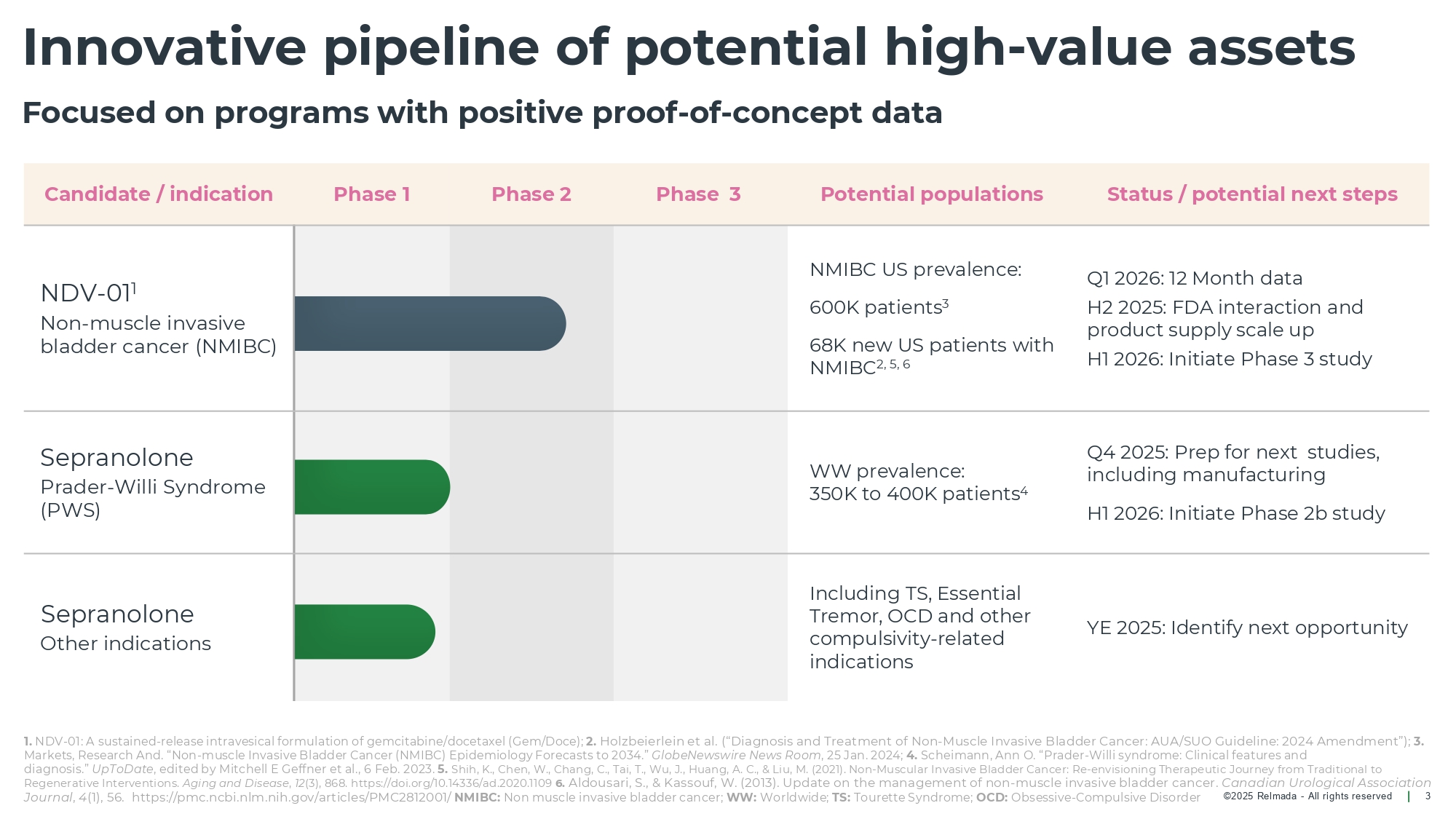
©2025 Relmada - All rights reserved 3 Innovative pipeline of potential high - value assets Focused on programs with positive proof - of - concept data Status / potential next steps Potential populations Phase 3 Phase 2 Phase 1 Candidate / indication Q1 2026: 12 Month data H2 2025: FDA interaction and product supply scale up H1 2026: Initiate Phase 3 study NMIBC US prevalence: 600K patients 3 68K new US patients with NMIBC 2, 5, 6 NDV - 01 1 Non - muscle invasive bladder cancer (NMIBC) Q4 2025: Prep for next studies, including manufacturing H1 2026: Initiate Phase 2b study WW prevalence: 350K to 400K patients 4 Sepranolone Prader - Willi Syndrome (PWS) YE 2025: Identify next opportunity Including TS, Essential Tremor, OCD and other compulsivity - related indications Sepranolone Other indications 1. NDV - 01: A sustained - release intravesical formulation of gemcitabine/docetaxel (Gem/Doce); 2. Holzbeierlein et al. (“Diagnosis and Treatment of Non - Muscle Invasive Bladder Cancer: AUA/SUO Guideline: 2024 Amendment”); 3. Markets, Research And. “Non - muscle Invasive Bladder Cancer (NMIBC) Epidemiology Forecasts to 2034.” GlobeNewswire News Room , 25 Jan. 2024; 4. Scheimann, Ann O. “Prader - Willi syndrome: Clinical features and diagnosis.” UpToDate , edited by Mitchell E Geffner et al., 6 Feb. 2023. 5. Shih, K., Chen, W., Chang, C., Tai, T., Wu, J., Huang, A. C., & Liu, M. (2021). Non - Muscular Invasive Bladder Cancer: Re - envisioning Therapeutic Journey from Traditional to Regenerative Interventions. Aging and Disease , 12 (3), 868. https://doi.org/10.14336/ad.2020.1109 6. Aldousari, S., & Kassouf, W. (2013). Update on the management of non - muscle invasive bladder cancer. Canadian Urological Association Journal , 4 (1), 56. https://pmc.ncbi.nlm.nih.gov/articles/PMC2812001/ NMIBC: Non muscle invasive bladder cancer; WW: Worldwide; TS: Tourette Syndrome; OCD: Obsessive - Compulsive Disorder

©2025 Relmada - All rights reserved 4 NDV - 01 A sustained - release intravesical formulation of gemcitabine/docetaxel (Gem/Doce) for patients with NMIBC, with positive Phase 2a data 1 1. American Urological Association 2025 presentation. Relmada press release and Investor Event April 28, 2025 NMIBC: Non - Muscle Invasive Bladder. The graphic is for artistic purposes only, not a factual representation
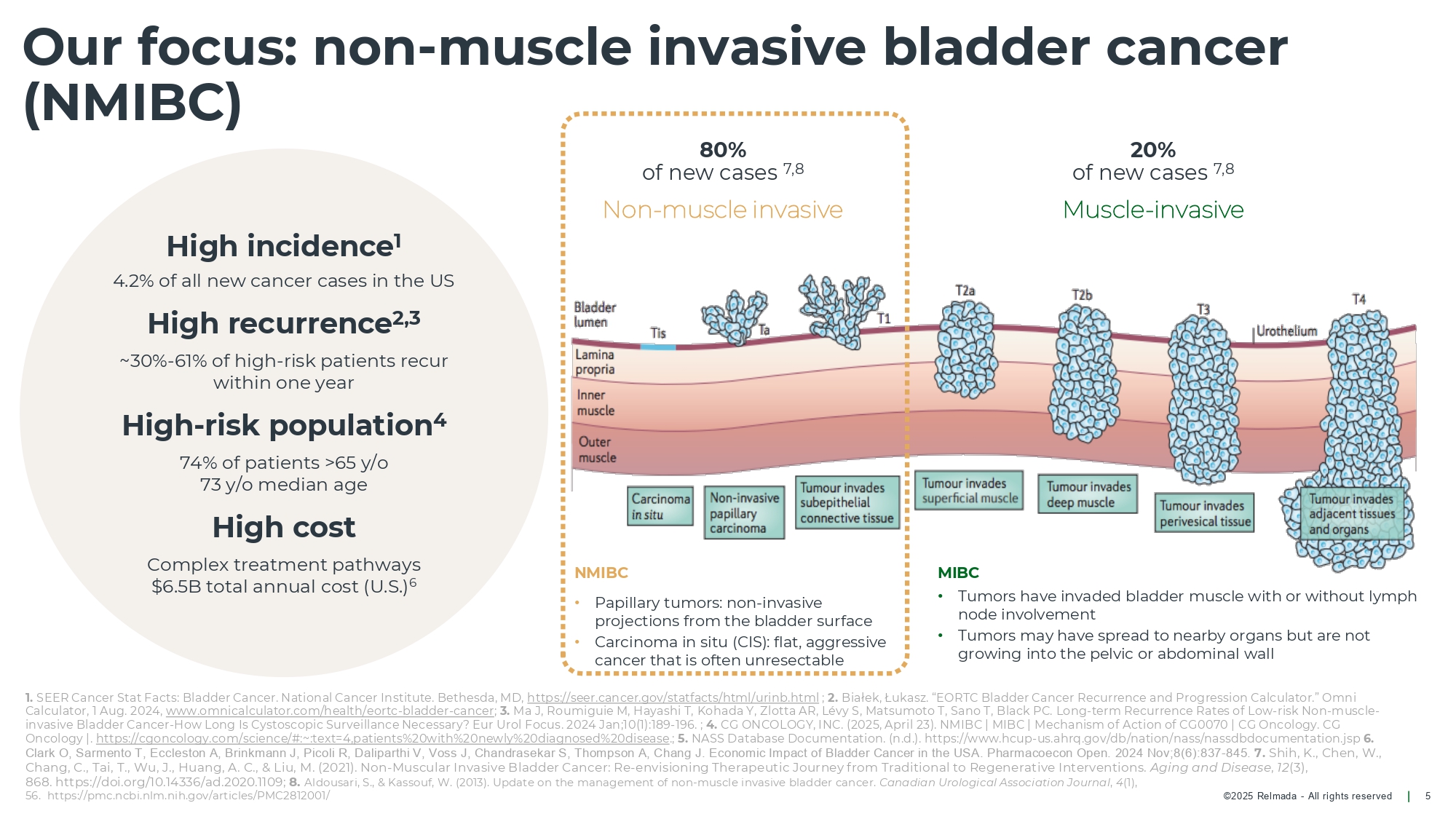
©2025 Relmada - All rights reserved Our focus: non - muscle invasive bladder cancer (NMIBC) 5 20% of new cases 7,8 Muscle - invasive 80% of new cases 7,8 Non - muscle invasive 1. SEER Cancer Stat Facts: Bladder Cancer. National Cancer Institute. Bethesda, MD, https://seer.cancer.gov/statfacts/html/urinb.htm l ; 2. Białek, Łukasz. “EORTC Bladder Cancer Recurrence and Progression Calculator.” Omni Calculator, 1 Aug. 2024, www.omnicalculator.com/health/eortc - bladder - cancer ; 3. Ma J, Roumiguie M, Hayashi T, Kohada Y, Zlotta AR, Lévy S, Matsumoto T, Sano T, Black PC. Long - term Recurrence Rates of Low - risk Non - muscle - invasive Bladder Cancer - How Long Is Cystoscopic Surveillance Necessary? Eur Urol Focus. 2024 Jan;10(1):189 - 196. ; 4. CG ONCOLOGY, INC. (2025, April 23). NMIBC | MIBC | Mechanism of Action of CG0070 | CG Oncology. CG Oncology |. https://cgoncology.com/science/#:~:text=4,patients%20with%20newly%20diagnosed%20disease .; 5. NASS Database Documentation. (n.d.). https:// www.hcup - us.ahrq.gov/db/nation/nass/nassdbdocumentation.jsp 6. Clark O, Sarmento T, Eccleston A, Brinkmann J, Picoli R, Daliparthi V, Voss J, Chandrasekar S, Thompson A, Chang J. Economic Impact of Bladder Cancer in the USA. Pharmacoecon Open. 2024 Nov;8(6):837 - 845. 7. Shih, K., Chen, W., Chang, C., Tai, T., Wu, J., Huang, A. C., & Liu, M. (2021). Non - Muscular Invasive Bladder Cancer: Re - envisioning Therapeutic Journey from Traditional to Regenerative Interventions. Aging and Disease , 12 (3), 868. https://doi.org/10.14336/ad.2020.1109; 8. Aldousari, S., & Kassouf, W. (2013). Update on the management of non - muscle invasive bladder cancer. Canadian Urological Association Journal , 4 (1), 56. https://pmc.ncbi.nlm.nih.gov/articles/PMC2812001/ High incidence 1 4.2% of all new cancer cases in the US High recurrence 2,3 ~30% - 61% of high - risk patients recur within one year High - risk population 4 74% of patients >65 y/o 73 y/o median age High cost Complex treatment pathways $6.5B total annual cost (U.S.) 6 NMIBC • Papillary tumors: non - invasive projections from the bladder surface • Carcinoma in situ (CIS): flat, aggressive cancer that is often unresectable MIBC • Tumors have invaded bladder muscle with or without lymph node involvement • Tumors may have spread to nearby organs but are not growing into the pelvic or abdominal wall

©2025 Relmada - All rights reserved NMIBC opportunity 6 New bladder cancer cases 2 71 - 97% 5 - year overall survival, 8% with advanced disease 3 NMIBC cancer cases (80% of bladder cancers) 4, 6, 8, 9 50 - 80% recurrence rate (over five years) 5 US prevalence of Bladder Cancer 1 (Overall Bladder Cancer) Intermediate - risk and high - risk have increased risk of recurrence and progression (Intermediate - risk represents 45% 6, 7 and high - risk represents 35% 7 of NMIBC cases) ~ 68,000 ~85,000 ~744,000 ~ 54,400 1. https://seer.cancer.gov/statfacts/html/urinb.htm l ; 2. The American Cancer Society medical and editorial content team. “Key Statistics for Bladder Cancer.” American Cancer Society, www.cancer.org/cancer/types/bladder - cancer/about/key - statistics.html; 3. National Cancer Institute “Bladder Cancer Prognosis and Survival Rates” ( https:// www.cancer.gov/types/bladder/survival# ); 4. Holzbeierlein et al. (“Diagnosis and Treatment of Non - Muscle Invasive Bladder Cancer: AUA/SUO Guideline: 2024 Amendment”); 5. Białek, Łukasz. “EORTC Bladder Cancer Recurrence and Progression Calculator.” Omni Calculator, 1 Aug. 2024, www.omnicalculator.com/health/eortc - bladder - cancer; 6. Seo, Munseok, and James R. Langabeer II. “Demographic and Survivorship Disparities in Non – muscle - invasive Bladder Cancer in the United States.” Journal of Preventive Medicine and Public Health, vol. 51, no. 5, Aug. 2018, pp. 242 – 47; 7. Nielsen, Matthew E., et al. “Trends in Stage-specific Incidence Rates for Urothelial Carcinoma of the Bladder in the United States: 1988 to 2006.” Cancer , vol. 120, no. 1, Oct. 2013, pp. 86 – 95, doi:10.1002/cncr.28397. 8. Shih, K., Chen, W., Chang, C., Tai, T., Wu, J., Huang, A. C., & Liu, M. (2021). Non - Muscular Invasive Bladder Cancer: Re - envisioning Therapeutic Journey from Traditional to Regenerative Interventions. Aging and Disease , 12 (3) 9. Aldousari, S., & Kassouf, W. (2013). Update on the management of non - muscle invasive bladder cancer. Canadian Urological Association Journal , 4 (1), 56. https://pmc.ncbi.nlm.nih.gov/articles/PMC2812001/ NMIBC: Non - Muscle Invasive Bladder; BCG: Bacillus Calmette - Guérin

©2025 Relmada - All rights reserved Current NMIBC patient care journey 7 Treatment begins with TURBT (transurethral resection of bladder tumor) surgery to stage, risk - stratify, and treat patients. Following surgery, patients with HR - NMIBC typically receive intravesical BCG as adjunctive treatment Urologists diagnose suspected cases of bladder cancer using cystoscopy and cytology. (Most common presenting symptom is blood in urine.) For patients with recurrent disease, repeat TURBT +/ - alternative intravesical treatments are used, including chemotherapies such as Gem/Doce Regular cystoscopies and urine cytology (up to every 3 months) are used to monitor patients and assess for recurrence/progression 1 2 3 4 5 Based on AUA/SUO Practice Guidelines, 2024 (Event April 28, 2025 (Holzbeierlein et al. (“Diagnosis and Treatment of Non - Muscle Invasive Bladder Cancer: AUA/SUO Guideline: 2024 Amendment”). HR: High Risk; NMIBC: Non - Muscle Invasive Bladder; BCG: Bacillus Calmette Guérin; TURBT: Trans Urethral Resection of Bladder Tumor; Gem/Doce : Gemcitabine plus Docetaxel
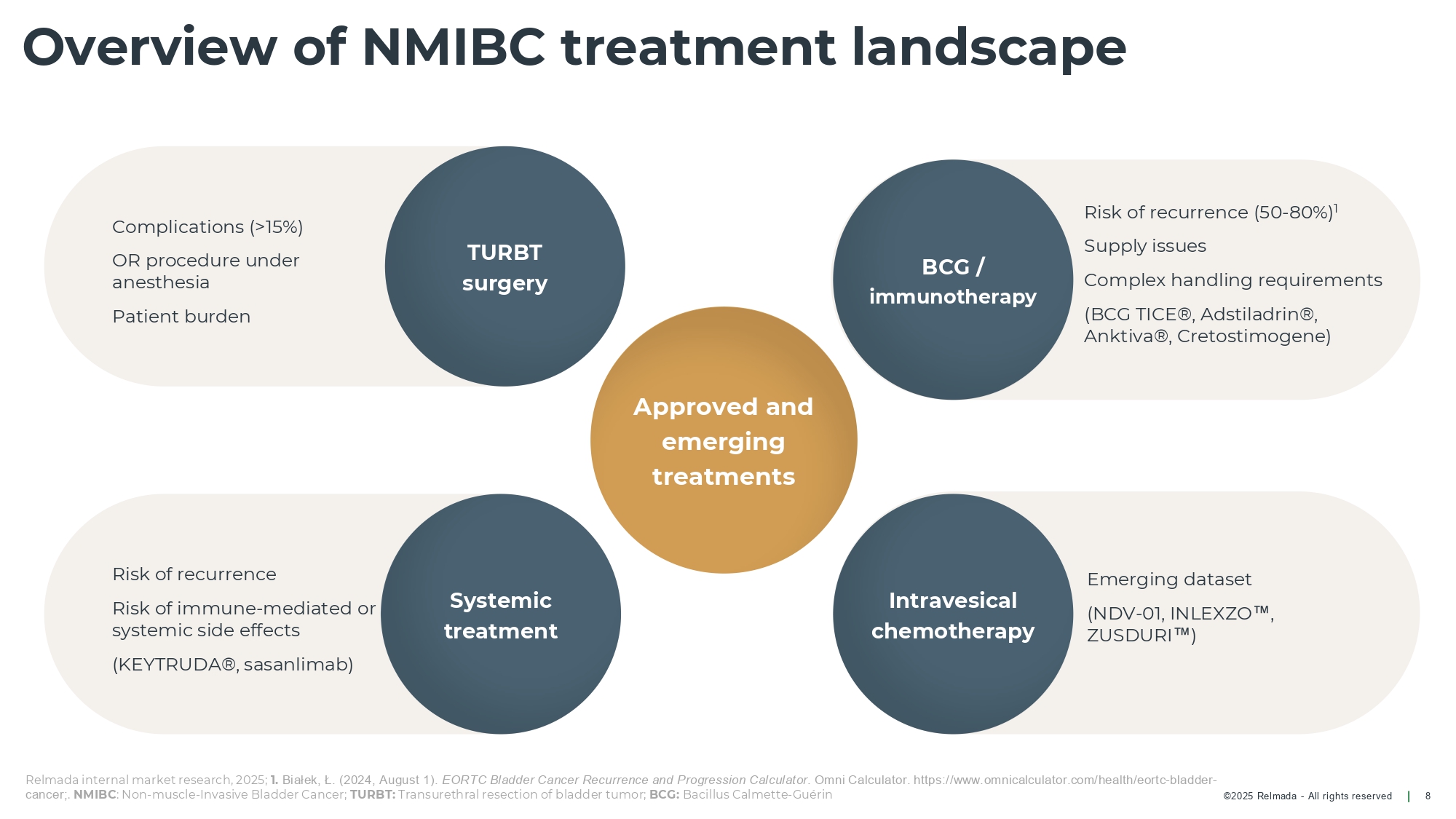
©2025 Relmada - All rights reserved Risk of recurrence (50 - 80%) 1 Supply issues Complex handling requirements (BCG TICE®, Adstiladrin®, Anktiva®, Cretostimogene) Emerging dataset (NDV - 01, INLEXZO , ZUSDURI ) Complications (>15%) OR procedure under anesthesia Patient burden Risk of recurrence Risk of immune - mediated or systemic side effects (KEYTRUDA®, sasanlimab) Intravesical chemotherapy Overview of NMIBC treatment landscape 8 Systemic treatment Approved and emerging treatments BCG / immunotherapy TURBT surgery Relmada internal market research, 2025; 1. Białek, Ł. (2024, August 1). EORTC Bladder Cancer Recurrence and Progression Calculator . Omni Calculator. https:// www.omnicalculator.com/health/eortc - bladder - cancer; . NMIBC : Non - muscle - Invasive Bladder Cancer; TURBT: Transurethral resection of bladder tumor; BCG: Bacillus Calmette - Guérin
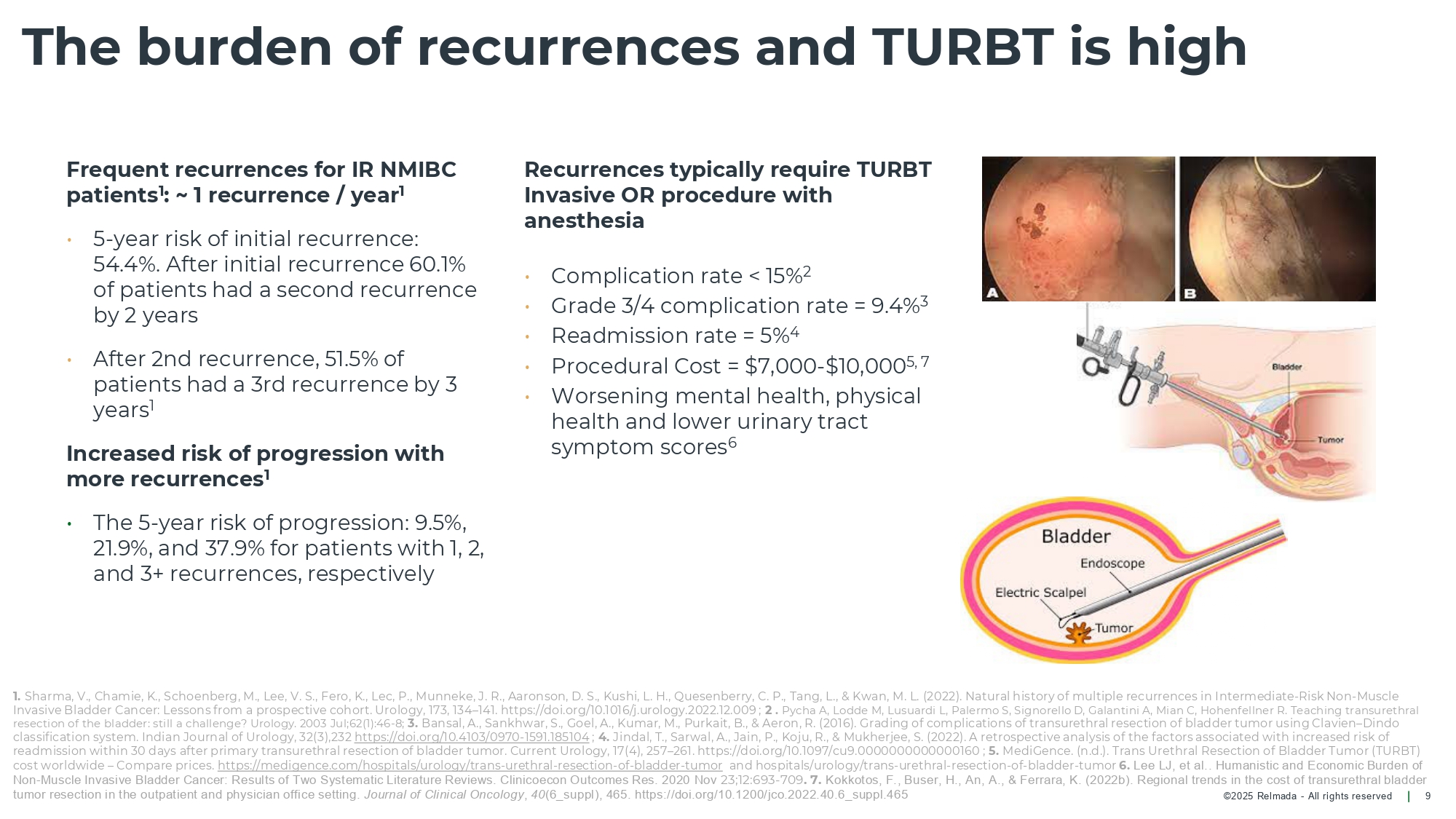
©2025 Relmada - All rights reserved 9 The burden of recurrences and TURBT is high Recurrences typically require TURBT Invasive OR procedure with anesthesia • Complication rate < 15% 2 • Grade 3/4 complication rate = 9.4% 3 • Readmission rate = 5% 4 • Procedural Cost = $7,000 - $10,000 5, 7 • Worsening mental health, physical health and lower urinary tract symptom scores 6 1. Sharma, V., Chamie, K., Schoenberg, M., Lee, V. S., Fero, K., Lec, P., Munneke, J. R., Aaronson, D. S., Kushi, L. H., Quesenberry, C. P., Tang, L., & Kwan, M. L. (2022). Natural history of multiple recurrences in Intermediate - Risk Non - Muscle Invasive Bladder Cancer: Lessons from a prospective cohort. Urology, 173, 134 – 141. https://doi.org/10.1016/j.urology.2022.12.009 ; 2 . Pycha A, Lodde M, Lusuardi L, Palermo S, Signorello D, Galantini A, Mian C, Hohenfellner R. Teaching transurethral resection of the bladder: still a challenge? Urology. 2003 Jul;62(1):46 - 8; 3. Bansal, A., Sankhwar, S., Goel, A., Kumar, M., Purkait, B., & Aeron, R. (2016). Grading of complications of transurethral resection of bladder tumor using Clavien – Dindo classification system. Indian Journal of Urology, 32(3),232 https://doi.org/10.4103/0970 - 1591.185104 ; 4. Jindal, T., Sarwal, A., Jain, P., Koju, R., & Mukherjee, S. (2022). A retrospective analysis of the factors associated with increased risk of readmission within 30 days after primary transurethral resection of bladder tumor. Current Urology, 17(4), 257 – 261. https://doi.org/10.1097/cu9.0000000000000160 ; 5. MediGence. (n.d.). Trans Urethral Resection of Bladder Tumor (TURBT) cost worldwide – Compare prices. https://medigence.com/hospitals/urology/trans - urethra l - resection - of - bladder - tumor and hospitals/urology/trans - urethral - resection - of - bladder - tumor 6. Lee LJ, et al.. Humanistic and Economic Burden of Non - Muscle Invasive Bladder Cancer: Results of Two Systematic Literature Reviews. Clinicoecon Outcomes Res. 2020 Nov 23;12:693 - 709 . 7. Kokkotos, F., Buser, H., An, A., & Ferrara, K. (2022b). Regional trends in the cost of transurethral bladder tumor resection in the outpatient and physician office setting. Journal of Clinical Oncology , 40 (6_suppl), 465. https://doi.org/10.1200/jco.2022.40.6_suppl.465 Frequent recurrences for IR NMIBC patients 1 : ~ 1 recurrence / year 1 • 5 - year risk of initial recurrence: 54.4%. After initial recurrence 60.1% of patients had a second recurrence by 2 years • After 2nd recurrence, 51.5% of patients had a 3rd recurrence by 3 years 1 Increased risk of progression with more recurrences 1 • The 5 - year risk of progression: 9.5%, 21.9%, and 37.9% for patients with 1, 2, and 3+ recurrences, respectively
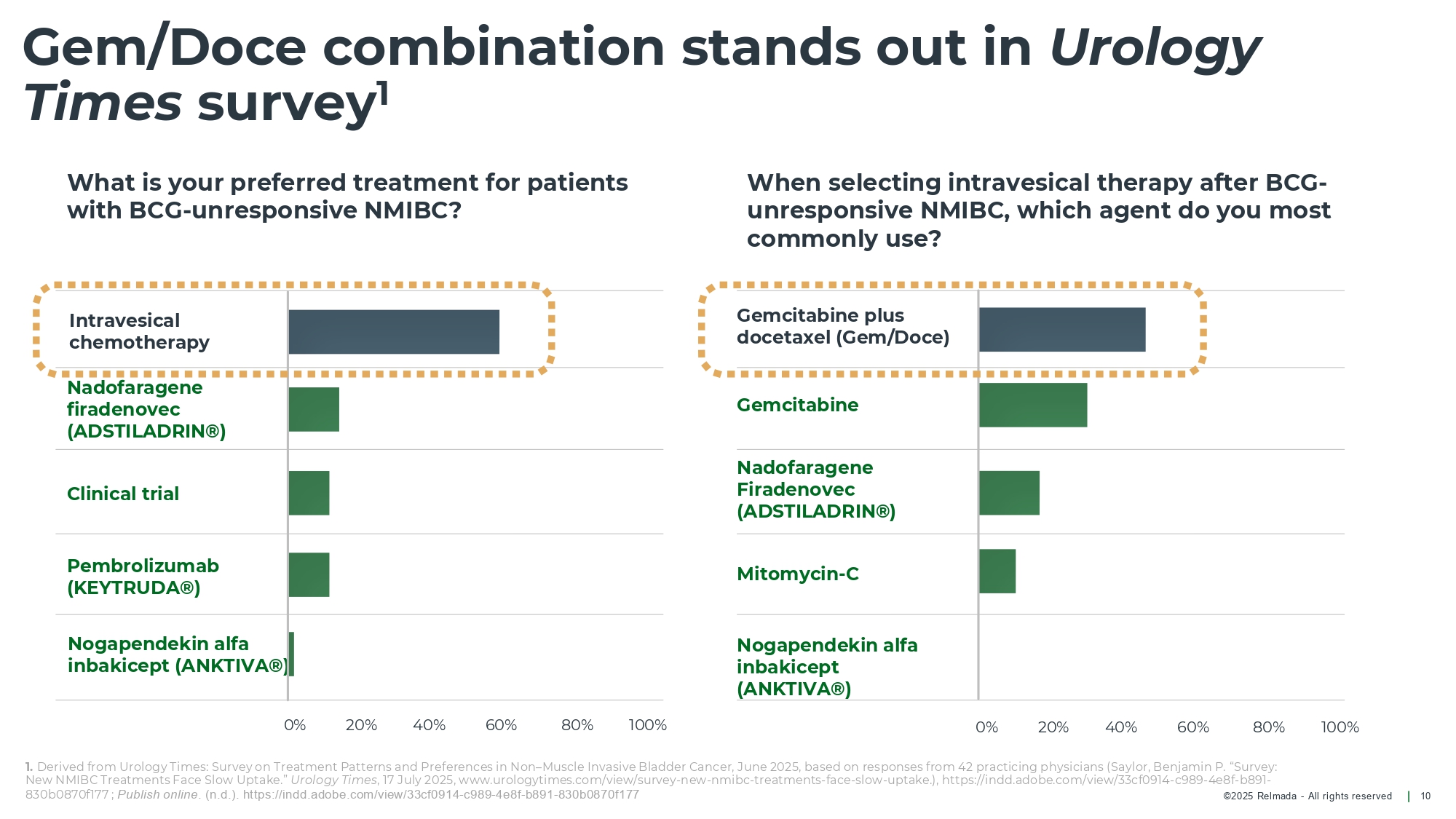
©2025 Relmada - All rights reserved Gem/Doce combination stands out in Urology Times survey 1 10 What is your preferred treatment for patients with BCG - unresponsive NMIBC? When selecting intravesical therapy after BCG - unresponsive NMIBC, which agent do you most commonly use? 1. Derived from Urology Times: Survey on Treatment Patterns and Preferences in Non – Muscle Invasive Bladder Cancer, June 2025, based on responses from 42 practicing physicians (Saylor, Benjamin P. “Survey: New NMIBC Treatments Face Slow Uptake.” Urology Times , 17 July 2025, www.urologytimes.com/view/survey - new - nmibc - treatments - face - slow - uptake.), https://indd.adobe.com/view/33cf0914 - c989 - 4e8f - b891 - 830b0870f177 ; Publish online . (n.d.). https://indd.adobe.com/view/33cf0914 - c989 - 4e8f - b891 - 830b0870f177 Clinical trial Nogapendekin alfa inbakicept (ANKTIVA®) Pembrolizumab (KEYTRUDA®) Intravesical chemotherapy Mitomycin - C Nogapendekin alfa inbakicept Nadofaragene Firadenovec (ADSTILADRIN®) Gemcitabine plus docetaxel (Gem/Doce) Gemcitabine Nadofaragene firadenovec (ADSTILADRIN®) 0% 20% 40% 60% 80% 100% (ANKTIVA®) 0% 20% 40% 60% 80% 100%

Gem/Doce combination has been embraced by the urologic oncology community 11 Effective salvage treatment for patients who have failed or are intolerant to BCG with reported 2 - year RFS ~50% 1, 2, 3 Gem/Doce is an effective alternative first - line agent in high - risk BCG naïve patients with 2 - year RFS of 82% 4 Gem/Doce use expanding into intermediate - risk and low - grade tumors with reported 2 - year RFS of 70 - 80% 5, 6 Gem/Doce avoids/delays radical cystectomy 7, 8 Large ongoing cooperative “BRIDGE” study (n=870) evaluating Gem/Doce combination v. BCG (NCT05538663) 1. Steinberg RL, Thomas LJ, Brooks N, et al. Multi - Institution Evaluation of Sequential Gemcitabine/Docetaxel as Rescue Therapy for NMIBC. J Urol. 2020; 2. Garneau CA, Marcotte N, Lacombe L, et al. Salvage therapy for BCG failure with intravesical sequential Gem/Doce in patients with recurrent NMIBC. Can Urol Assoc J J Assoc Urol Can. 2024; 3. Yim K, Melnick K, Mott SL, et al. Sequential intravesical gemcitabine/docetaxel provides a durable remission in recurrent high - risk NMIBC following BCG therapy. Urol Oncol. 2023; 4. McElree IM, Steinberg RL, Martin AC, et al. Sequential Intravesical gemcitabine/docetaxel for BCG - Naïve High - Risk NMIBC. J Urol. 2022; 5. McElree IM, Orzel J, Stubbee R, et al. Sequential intravesical gemcitabine/docetaxel for treatment - naïve and previously treated intermediate - risk NMIBC. Urol Oncol. 2023; 6. Tan WS, McElree IM, Davaro F, et al. Sequential Intravesical Gemcitabine/Docetaxel is an Alternative to BCG for the Treatment of Intermediate - risk NMIBC. Eur Urol Oncol. 2023; 7. Chevuru PT, McElree IM, Mott SL, Steinberg RL, O’Donnell MA, Packiam VT. Long - term follow - up of sequential intravesical gemcitabine and docetaxel salvage therapy for NMIBC. Urol Oncol. 2023; 8. Narayan VM, Boorjian SA, Alemozaffar M, et al. Efficacy of Intravesical Nadofaragene Firadenovec for Patients With BCG - Unresponsive NMIBC: 5 - Year Follow - Up From a Phase 3 Trial. J Urol. 2024. 9 . Steinberg, et. Al (2019). Multi - Institution evaluation of sequential gemcitabine and Docetaxel as rescue therapy for nonmuscle invasive bladder cancer. The Journal of Urology , 203 (5), 902 – 909. https://doi.org/10.1097/ju.0000000000000688 RFS: Relapse Free Survival; BCG: Bacillus Calmette - Guérin; NMIBC: Non - muscle - Invasive Bladder Cancer; Gem/Doce : Gemcitabine plus Docetaxel ©2025 Relmada - All rights reserved
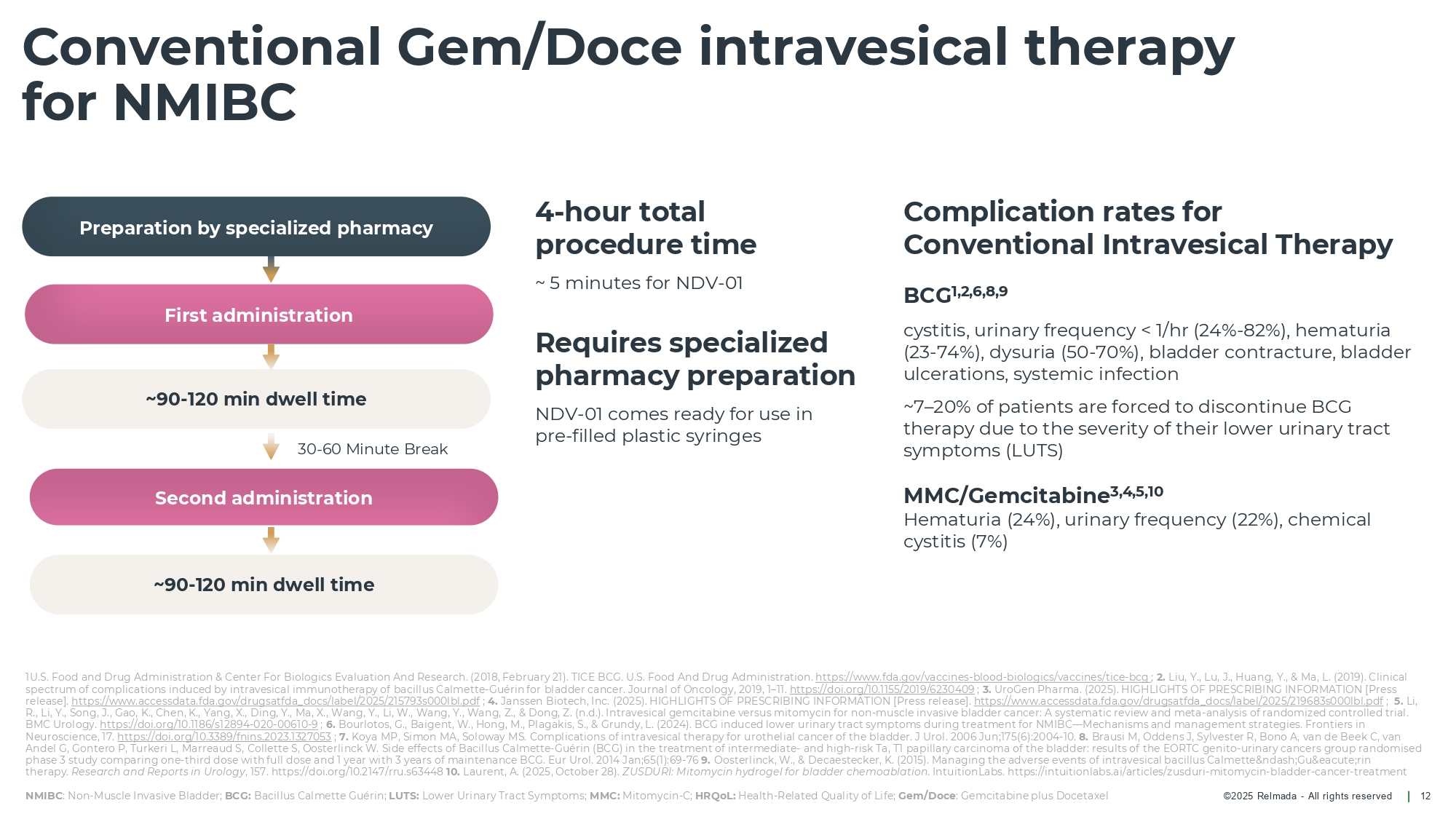
1U.S. Food and Drug Administration & Center For Biologics Evaluation And Research. (2018, February 21). TICE BCG. U.S. Food And Drug Administration. https://www.fda.gov/vaccines - blood - biologics/vaccines/tice - bc g ; 2. Liu, Y., Lu, J., Huang, Y., & Ma, L. (2019). Clinical spectrum of complications induced by intravesical immunotherapy of bacillus Calmette - Guérin for bladder cancer. Journal of Oncology, 2019, 1 – 11. https://doi.org/10.1155/2019/6230409 ; 3. UroGen Pharma. (2025). HIGHLIGHTS OF PRESCRIBING INFORMATION [Press release]. https://www.accessdata.fda.gov/drugsatfda_docs/label/2025/215793s000lbl.pdf ; 4. Janssen Biotech, Inc. (2025). HIGHLIGHTS OF PRESCRIBING INFORMATION [Press release]. https://www.accessdata.fda.gov/drugsatfda_docs/label/2025/219683s000lbl.pdf ; 5. Li, R., Li, Y., Song, J., Gao, K., Chen, K., Yang, X., Ding, Y., Ma, X., Wang, Y., Li, W., Wang, Y., Wang, Z., & Dong, Z. (n.d.). Intravesical gemcitabine versus mitomycin for non - muscle invasive bladder cancer: A systematic review and meta - analysis of randomized controlled trial. BMC Urology. https://doi.org/10.1186/s12894 - 020 - 00610 - 9 ; 6. Bourlotos, G., Baigent, W., Hong, M., Plagakis, S., & Grundy, L. (2024). BCG induced lower urinary tract symptoms during treatment for NMIBC — Mechanisms and management strategies. Frontiers in Neuroscience, 17. https://doi.org/10.3389/fnins.2023.1327053 ; 7. Koya MP, Simon MA, Soloway MS. Complications of intravesical therapy for urothelial cancer of the bladder. J Urol. 2006 Jun;175(6):2004 - 10. 8. Brausi M, Oddens J, Sylvester R, Bono A, van de Beek C, van Andel G, Gontero P, Turkeri L, Marreaud S, Collette S, Oosterlinck W. Side effects of Bacillus Calmette - Guérin (BCG) in the treatment of intermediate - and high - risk Ta, T1 papillary carcinoma of the bladder: results of the EORTC genito - urinary cancers group randomised phase 3 study comparing one - third dose with full dose and 1 year with 3 years of maintenance BCG. Eur Urol. 2014 Jan;65(1):69 - 76 9. Oosterlinck, W., & Decaestecker, K. (2015). Managing the adverse events of intravesical bacillus Calmette–Guérin therapy. Research and Reports in Urology , 157. https://doi.org/10.2147/rru.s63448 10. Laurent, A. (2025, October 28). ZUSDURI: Mitomycin hydrogel for bladder chemoablation . IntuitionLabs. https://intuitionlabs.ai/articles/zusduri - mitomycin - bladder - cancer - treatment NMIBC : Non - Muscle Invasive Bladder; BCG: Bacillus Calmette Guérin; LUTS: Lower Urinary Tract Symptoms; MMC: Mitomycin - C; HRQoL: Health - Related Quality of Life; Gem/Doce : Gemcitabine plus Docetaxel ©2025 Relmada - All rights reserved 12 Conventional Gem/Doce intravesical therapy for NMIBC First administration Preparation by specialized pharmacy ~90 - 120 min dwell time Second administration ~90 - 120 min dwell time 30 - 60 Minute Break 4 - hour total procedure time ~ 5 minutes for NDV - 01 Requires specialized pharmacy preparation NDV - 01 comes ready for use in pre - filled plastic syringes Complication rates for Conventional Intravesical Therapy BCG 1,2,6,8,9 cystitis, urinary frequency < 1/hr (24% - 82%), hematuria (23 - 74%), dysuria (50 - 70%), bladder contracture, bladder ulcerations, systemic infection ~7 – 20% of patients are forced to discontinue BCG therapy due to the severity of their lower urinary tract symptoms (LUTS) MMC/Gemcitabine 3,4,5,10 Hematuria (24%), urinary frequency (22%), chemical cystitis (7%)

©2025 Relmada - All rights reserved Targeted intravesical therapy 13 Diffusion through pores Diffusion through the polymer Osmotic pumping Erosion Bladder - targeted solid matrix enables prolonged tumor exposure to the cytotoxic drug combination via multiple delivery modalities
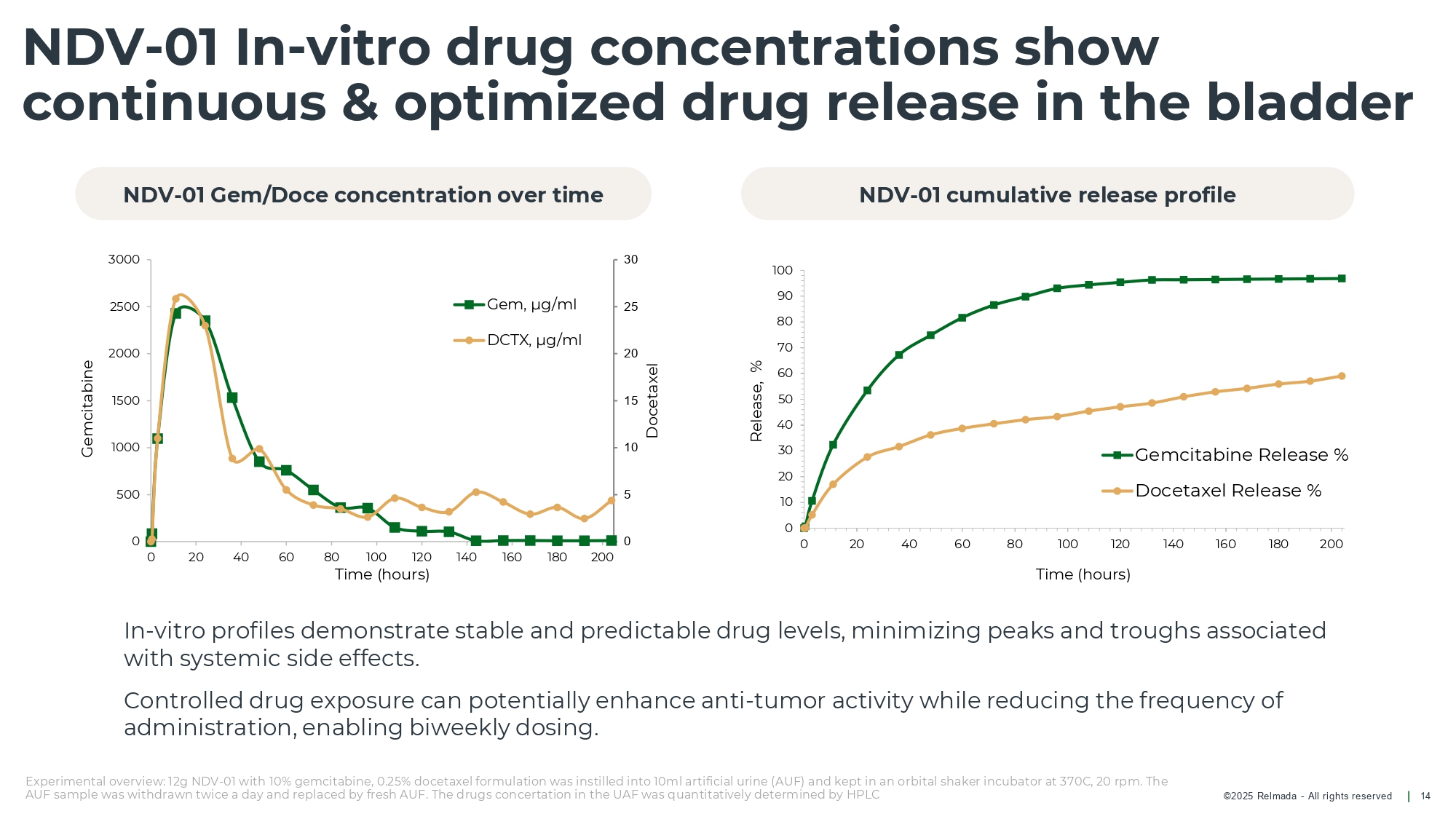
©2025 Relmada - All rights reserved NDV - 01 In - vitro drug concentrations show continuous & optimized drug release in the bladder 14 In - vitro profiles demonstrate stable and predictable drug levels, minimizing peaks and troughs associated with systemic side effects. Controlled drug exposure can potentially enhance anti - tumor activity while reducing the frequency of administration, enabling biweekly dosing. 100 90 80 70 60 50 40 30 20 10 0 0 20 40 60 80 100 120 Time (hours) 140 160 180 200 Release, % Gemcitabine Release % Docetaxel Release % 0 5 10 15 20 25 30 0 500 1000 1500 2000 2500 3000 0 20 40 60 80 100 120 140 160 180 200 Time (hours) Docetaxel Gemcitabine Gem, µg/ml DCTX, µg/ml NDV - 01 Gem/Doce concentration over time NDV - 01 cumulative release profile Experimental overview: 12g NDV - 01 with 10% gemcitabine, 0.25% docetaxel formulation was instilled into 10ml artificial urine (AUF) and kept in an orbital shaker incubator at 370C, 20 rpm. The AUF sample was withdrawn twice a day and replaced by fresh AUF. The drugs concertation in the UAF was quantitatively determined by HPLC

©2025 Relmada - All rights reserved NDV - 01 Competitive advantages 15 Based on an existing effective treatment Gem/Doce, an existing, effective and well understood treatment for NMIBC, is frequently used by urologists Ready for use NDV - 01 is supplied as a prefilled syringe ready for use, easily instilled manually in < 5 minutes Sustained release NDV - 01 releases Gem/Doce inside the bladder continuously for 10 days , resulting in sustained tumor exposure and meaningful improvement in patient outcome Safely excreted NDV - 01 polymer is biodegradable, gradually disintegrates, and is safely excreted via the urine NDV - 01 is an investigational intravesical therapy designed for the extended release of gemcitabine and docetaxel (Gem/Doce) Convenience Patient is treated in doctors' office Relmada internal market research 2025. NMIBC: Non - muscle - Invasive Bladder Cancer; Gem/Doce : Gemcitabine plus Docetaxel
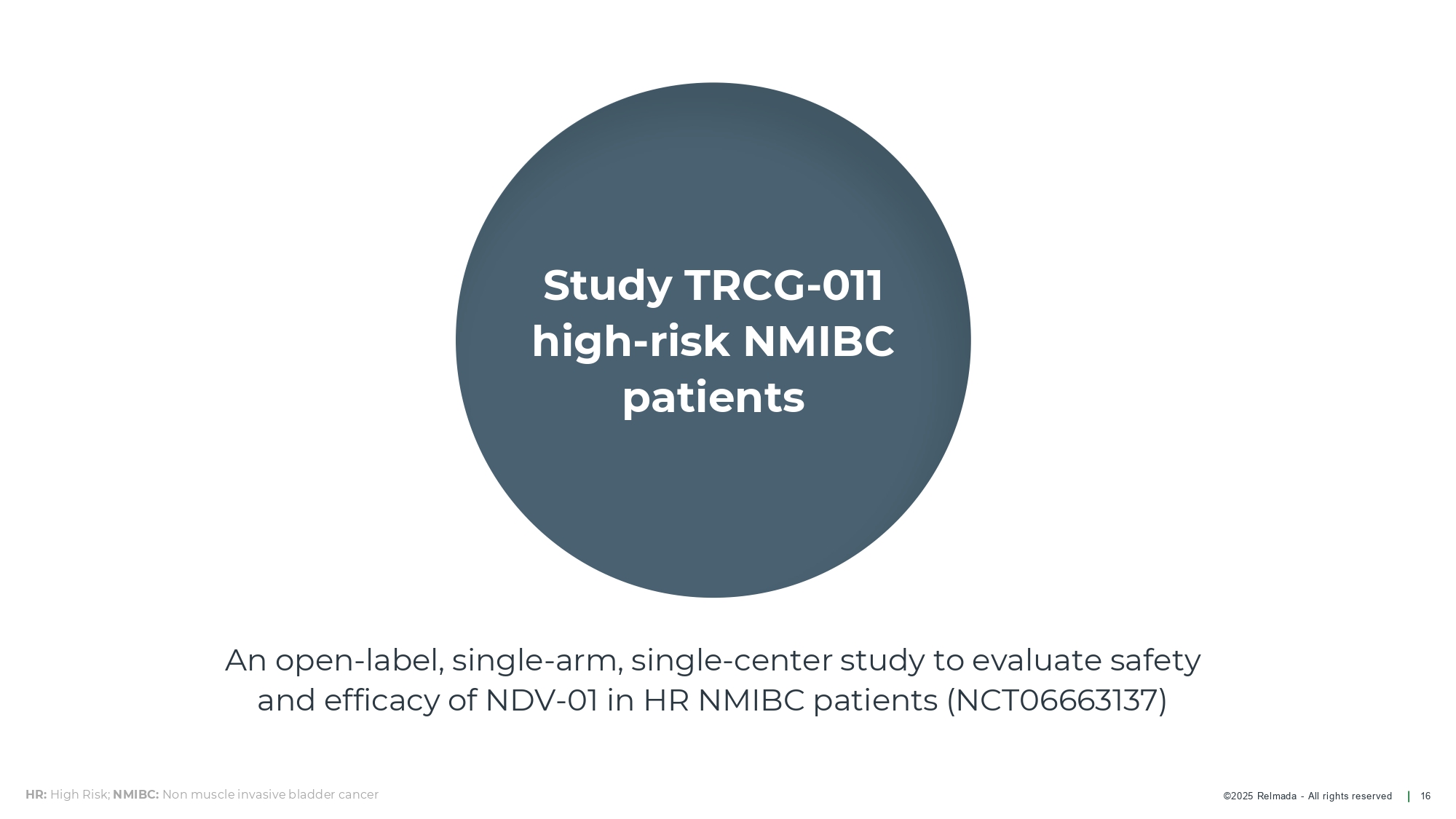
©2025 Relmada - All rights reserved 16 Study TRCG - 011 high - risk NMIBC patients An open - label, single - arm, single - center study to evaluate safety and efficacy of NDV - 01 in HR NMIBC patients (NCT06663137) HR: High Risk; NMIBC: Non muscle invasive bladder cancer
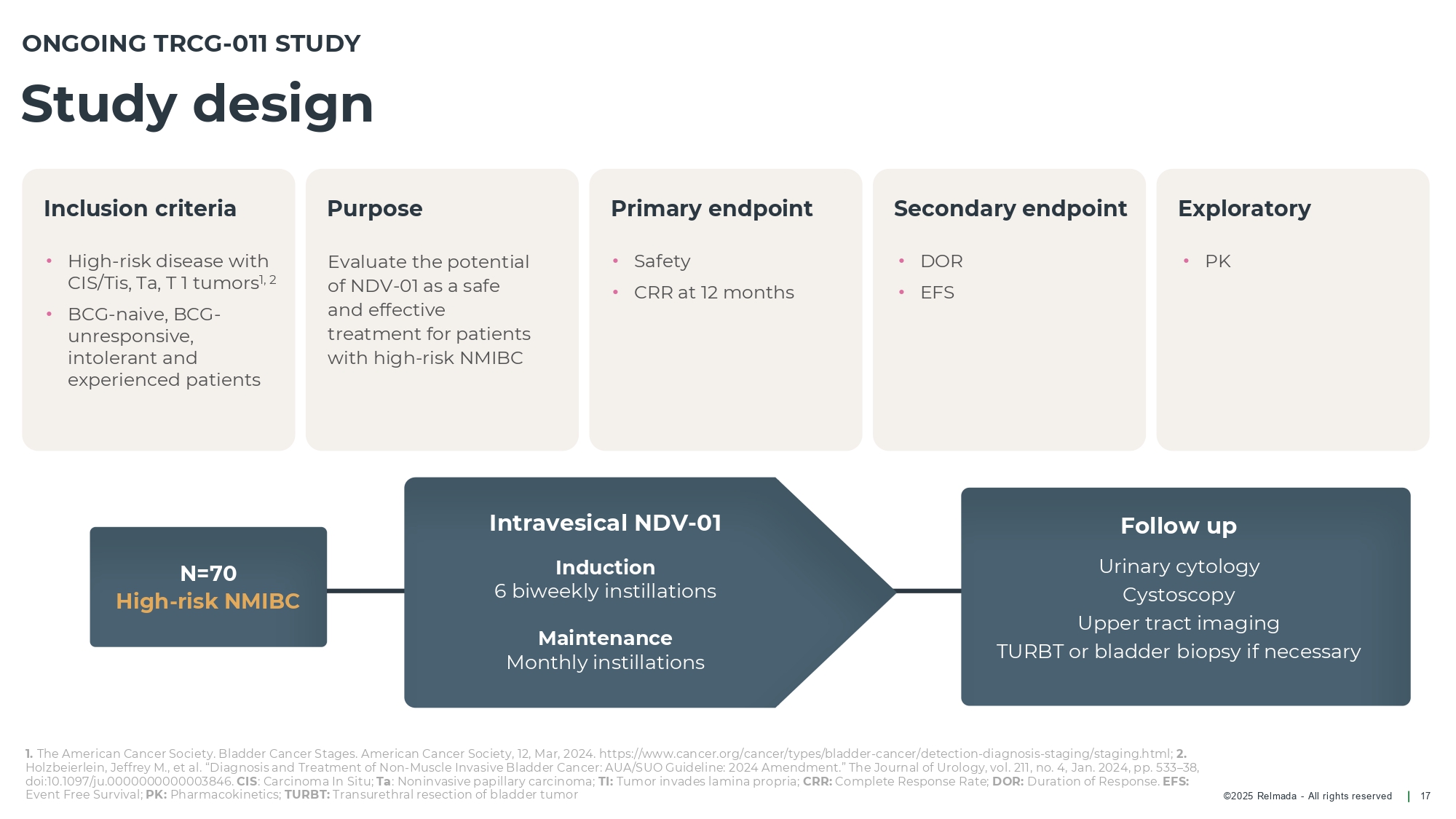
©2025 Relmada - All rights reserved Inclusion criteria Purpose Primary endpoint Secondary endpoint Exploratory Study design 17 N=70 High - risk NMIBC • High - risk disease with CIS/Tis, Ta, T 1 tumors 1, 2 • BCG - naive, BCG - unresponsive, intolerant and experienced patients Evaluate the potential of NDV - 01 as a safe and effective treatment for patients with high - risk NMIBC • Safety • CRR at 12 months • DOR • EFS • PK ONGOING TRCG - 011 STUDY Follow up Urinary cytology Cystoscopy Upper tract imaging TURBT or bladder biopsy if necessary Intravesical NDV - 01 Induction 6 biweekly instillations Maintenance Monthly instillations 1. The American Cancer Society. Bladder Cancer Stages. American Cancer Society, 12, Mar, 2024. https:// www.cancer.org/cancer/types/bladder - cancer/detection - diagnosis - staging/staging.html; 2. Holzbeierlein, Jeffrey M., et al. “Diagnosis and Treatment of Non - Muscle Invasive Bladder Cancer: AUA/SUO Guideline: 2024 Amendment.” The Journal of Urology, vol. 211, no. 4, Jan. 2024, pp. 533 – 38, doi:10.1097/ju.0000000000003846. CIS : Carcinoma In Situ; Ta : Noninvasive papillary carcinoma; TI: Tumor invades lamina propria; CRR: Complete Response Rate; DOR: Duration of Response. EFS: Event Free Survival; PK: Pharmacokinetics; TURBT: Transurethral resection of bladder tumor
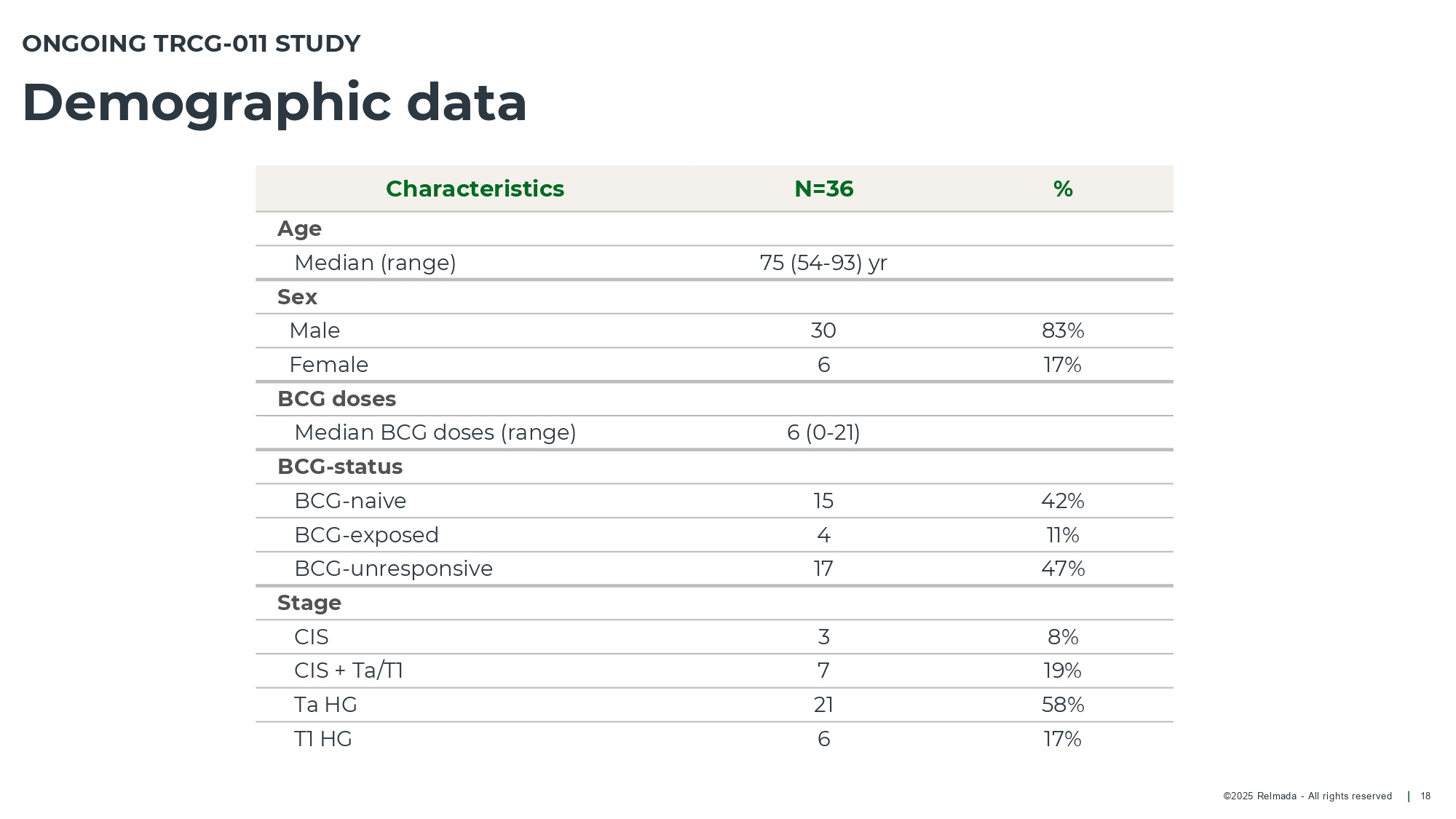
©2025 Relmada - All rights reserved Demographic data 18 ONGOING TRCG - 011 STUDY % N=36 Characteristics Age 75 (54 - 93) yr Median (range) Sex 83% 30 Male 17% 6 Female BCG doses 6 (0 - 21) Median BCG doses (range) BCG - status 42% 15 BCG - naive 11% 4 BCG - exposed 47% 17 BCG - unresponsive Stage 8% 3 CIS 19% 7 CIS + Ta/T1 58% 21 Ta HG 17% 6 T1 HG
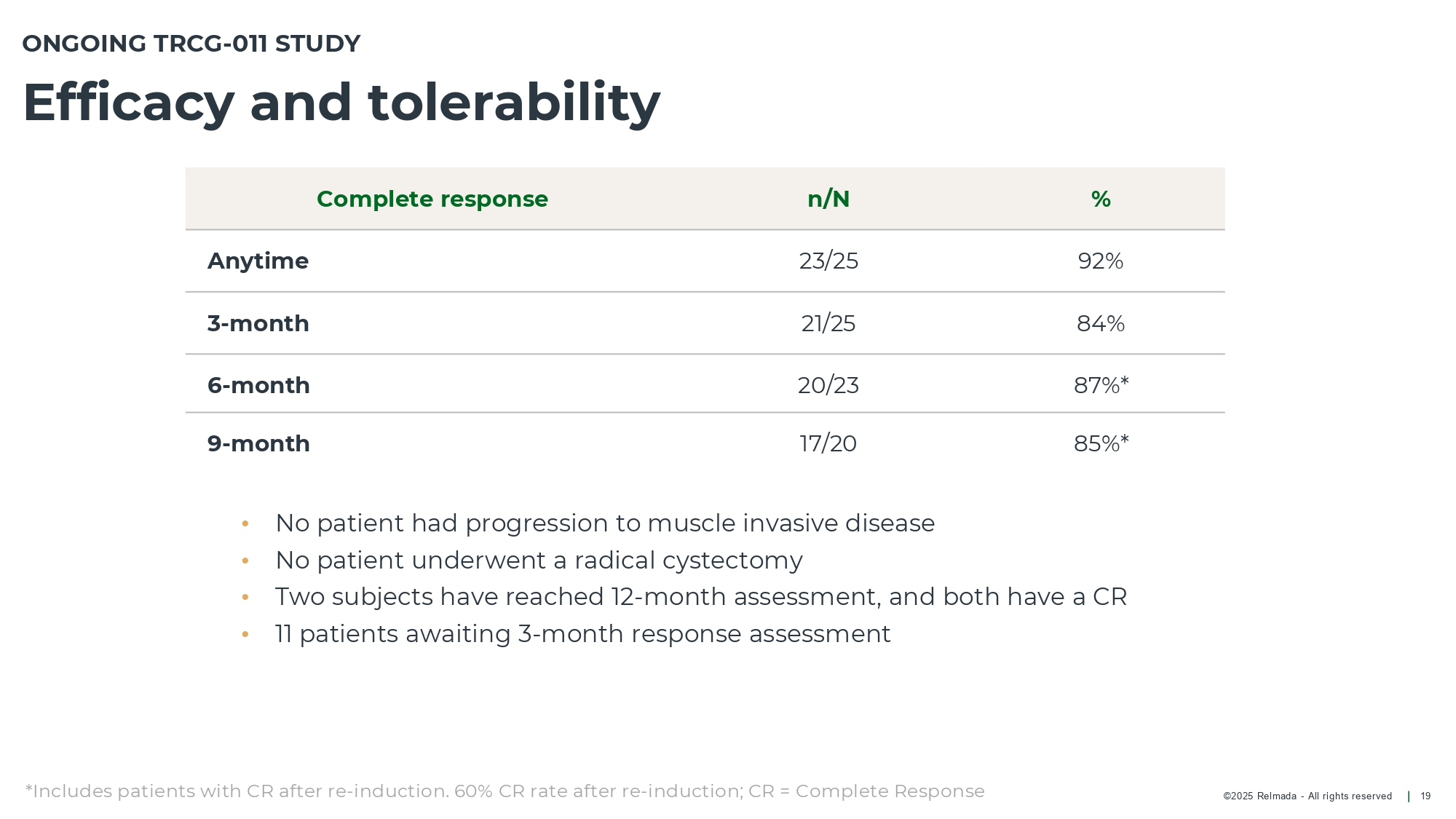
©2025 Relmada - All rights reserved ONGOING TRCG - 011 STUDY Efficacy and tolerability 19 *Includes patients with CR after re - induction. 60% CR rate after re - induction; CR = Complete Response % n/N Complete response 92% 23/25 Anytime 84% 21/25 3 - month 87%* 20/23 6 - month • No patient had progression to muscle invasive disease • No patient underwent a radical cystectomy • Two subjects have reached 12 - month assessment, and both have a CR • 11 patients awaiting 3 - month response assessment 85%* 17/20 9 - month
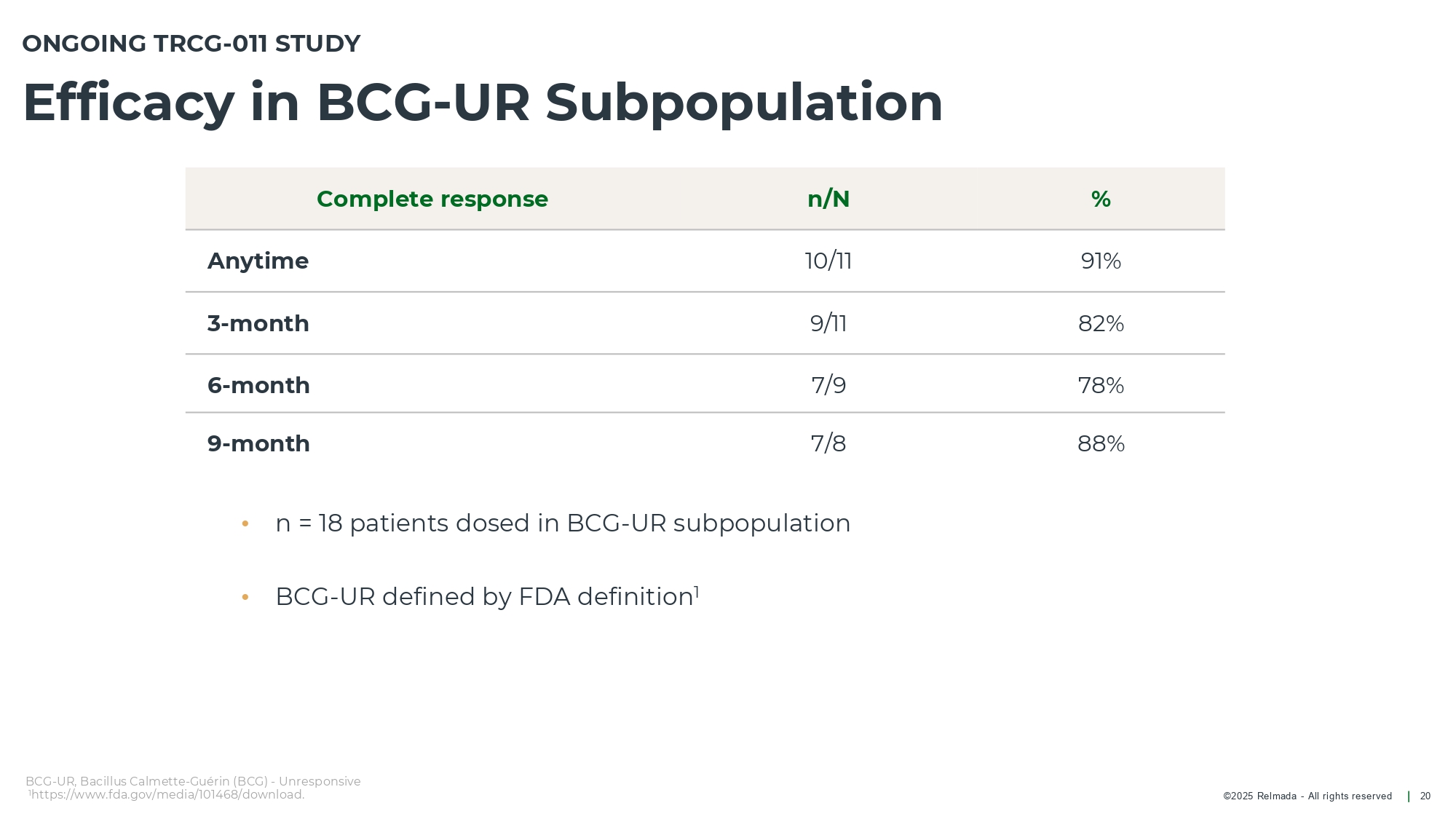
©2025 Relmada - All rights reserved ONGOING TRCG - 011 STUDY Efficacy in BCG - UR Subpopulation 20 BCG - UR, Bacillus Calmette - Guérin (BCG) - Unresponsive 1 https:// www.fda.gov/media/101468/download. % n/N Complete response 91% 10/11 Anytime 82% 9/11 3 - month 78% 7/9 6 - month • n = 18 patients dosed in BCG - UR subpopulation • BCG - UR defined by FDA definition 1 88% 7/8 9 - month

©2025 Relmada - All rights reserved 01 - 002 01 - 015 Pending 01 - 003 01 - 007 Pending Pending 01 - 009 01 - 010 Pending Pending 01 - 011 01 - 013 Pending Pending 01 - 014 01 - 019 Pending Pending 01 - 020 01 - 024 Pending Pending 01 - 025 01 - 027 Pending Pending 01 - 005 01 - 004 Pending Pending 01 - 021 01 - 018 Discontinued Pending 01 - 022 01 - 023 Pending Pending 01 - 028 01 - 029 Discontinued Pending 01 - 030 01 - 032 Pending Discontinued 01 - 001 01 - 033 Pending Pending 01 - 034 01 - 035 Pending 01 - 036 Pending 01 - 037 Pending 01 - 038 Pending 01 - 039 Pending 01 - 040 Pending 01 - 041 Pending 01 - 042 Pending 01 - 043 CIS BCG - UR Ta BCG - naive CIS BCG - naive T 1 BCG - exposed T 1 BCG - UR T 1 BCG - naive T 1 + CIS BCG - naive Ta BCG - exposed Ta BCG - naive Ta BCG - UR Ta BCG - UR Ta BCG - naive Ta BCG - naive Ta BCG - UR T 1 + CIS BCG - UR CIS BCG - naive Ta BCG - UR Ta BCG - exposed Ta BCG - naive Ta BCG - naive Ta BCG - UR Ta BCG - UR Ta BCG - UR Ta BCG - UR T 1 BCG - naive T 1 BCG - naive T 1 + CIS BCG - UR Ta BCG - UR Ta BCG - UR Ta BCG - exposed Ta BCG - naive Ta BCG - naive T 1 + CIS BCG - UR T 1 + CIS BCG - UR Ta + CIS BCG - naive Ta + CIS BCG - UR Pending Patient # Stage BCG status 3 months 6 months 9 months 12 months Durable response over time 21 CR : Complete response; BCG - UR, Bacillus Calmette - Guérin (BCG) – Unresponsive; BCG - UR, BCG, Bacillus Calmette - Guérin 92% Anytime CR rate 84% 3 - month CR rate 87% 6 - month CR rate Pending completion 85% 9 - month CR rate CR Non - CR Re - induced Ongoing

©2025 Relmada - All rights reserved Treatment - related AE and tolerability 22 No patient had >= Grade 3 TRAE Of the 36 patients who received >= 1 dose of NDV - 01, 22 (61%) had a TRAE • 62% transient uncomfortable urination (dysuria) • 9% asymptomatic positive urine culture • 7% hematuria No patients discontinued treatment due to AEs ONGOING TRCG - 011 STUDY TRAE: Treatment - related adverse events; AE: Adverse events.
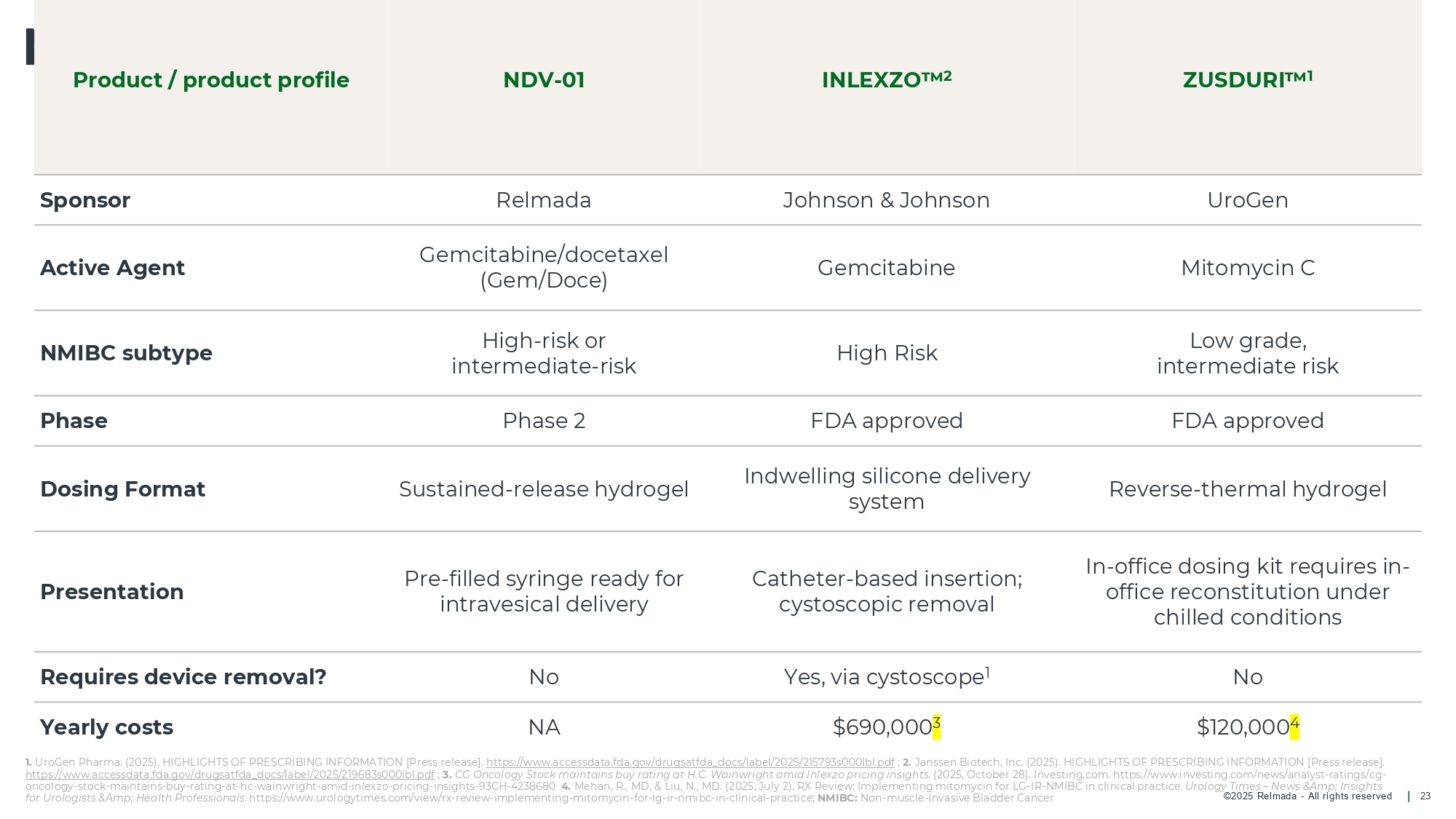
©2025 Relmada - All rights reserved DV - 01 comp ared 23 1 . UroGen Pharma . ( 2025 ) . HIGHLIGHTS OF PRESCRIBING INFORMATION [Press release] . https : //www . accessdata . fda . gov/drugsatfda_docs/label/ 2025 / 215793 s 000 lbl . pdf ; 2 . Janssen Biotech, Inc . ( 2025 ) . HIGHLIGHTS OF PRESCRIBING INFORMATION [Press release] . https : //www . accessdata . fda . gov/drugsatfda_docs/label/ 2025 / 219683 s 000 lbl . pdf ; 3 . CG Oncology Stock maintains buy rating at H . C . Wainwright amid Inlexzo pricing insights . ( 2025 , October 28 ) . Investing . com . https : // www . investing . com/news/analyst - ratings/cg - oncology - stock - maintains - buy - rating - at - hc - wainwright - amid - inlexzo - pricing - insights - 93 CH - 4238680 4 . Mehan, R . , MD, & Liu, N . , MD . ( 2025 , July 2 ) . RX Review : Implementing mitomycin for LG - IR - NMIBC in clinical practice . Urology Times – News &Amp ; Insights for Urologists &Amp; Health Professionals . https:// www.urologytimes.com/view/rx - review - implementing - mitomycin - for - lg - ir - nmibc - in - clinical - practice; NMIBC: Non - muscle - Invasive Bladder Cancer ZUSDURI 1 INLEXZO 2 NDV - 01 N Product / product profile UroGen Johnson & Johnson Relmada Sponsor Mitomycin C Gemcitabine Gemcitabine/docetaxel (Gem/Doce) Active Agent Low grade, intermediate risk High Risk High - risk or intermediate - risk NMIBC subtype FDA approved FDA approved Phase 2 Phase Reverse - thermal hydrogel Indwelling silicone delivery system Sustained - release hydrogel Dosing Format In - office dosing kit requires in - office reconstitution under chilled conditions Catheter - based insertion; cystoscopic removal Pre - filled syringe ready for intravesical delivery Presentation No Yes, via cystoscope 1 No Requires device removal? $120,000 4 $690,000 3 NA Yearly costs
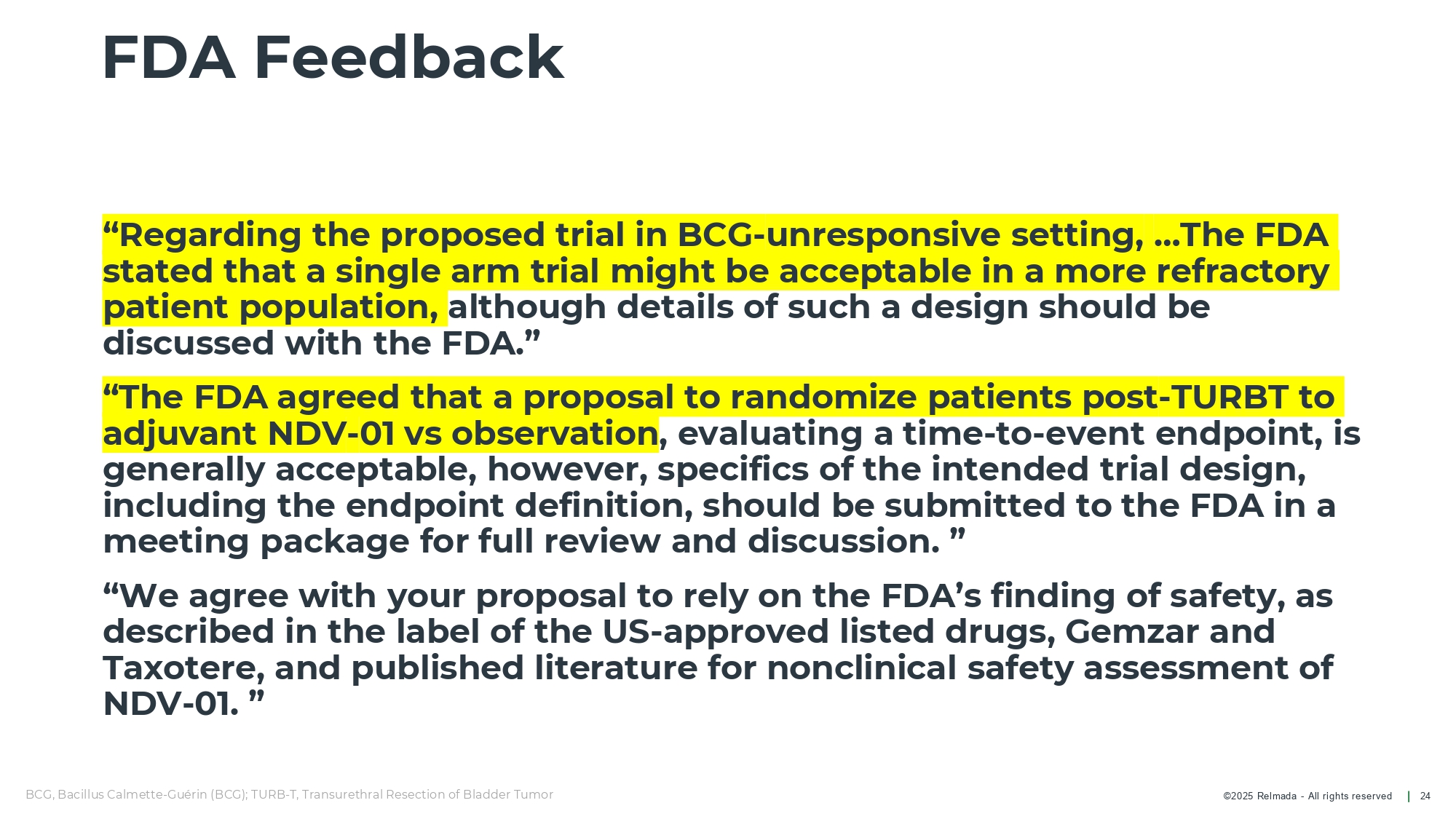
©2025 Relmada - All rights reserved FDA Feedback “Regarding the proposed trial in BCG - unresponsive setting, …The FDA stated that a single arm trial might be acceptable in a more refractory patient population, although details of such a design should be discussed with the FDA.” “The FDA agreed that a proposal to randomize patients post - TURBT to adjuvant NDV - 01 vs observation , evaluating a time - to - event endpoint, is generally acceptable, however, specifics of the intended trial design, including the endpoint definition, should be submitted to the FDA in a meeting package for full review and discussion. ” “We agree with your proposal to rely on the FDA’s finding of safety, as described in the label of the US - approved listed drugs, Gemzar and Taxotere, and published literature for nonclinical safety assessment of NDV - 01. ” 24 BCG, Bacillus Calmette - Guérin (BCG); TURB - T, Transurethral Resection of Bladder Tumor

©2025 Relmada - All rights reserved Regulatory and Clinical Strategy 25 • Single - arm trial in BCG - unresponsive NMIBC with CIS who are refractory to other therapies o Request type B meeting o Protocol in development • RCT in IR NMIBC – adjuvant therapy after TURBT (NDV - 01 vs observation) o Type B meeting requested o Protocol is in development to finalize for FDA Briefing Book submission BCG, Bacillus Calmette - Guérin (BCG); TURB - T, Transurethral Resection of Bladder Tumor; RCT, randomized controlled trial; CIS, carcinoma in situ

©2025 Relmada - All rights reserved Proposed Pivotal Trial in BCG - Unresponsive NMIBC 26 • HG BCG - UR with CIS refractory to first - line therapy • Safety and efficacy of NDV - 01 in patients with HG BCG - UR with CIS Intravesical NDV - 01 Induction 6 biweekly instillations Maintenance Monthly instillations Follow up Urinary cytology Cystoscopy TURBT or bladder bx if necessary CR: Complete Response; DOR: Duration of Response; RFS: Recurrence Free Survival; PFS: Progression Free Survival. N=~100 HR BCG - UR NMIBC refractory to 1 st line therapy Study design Open - label, single - arm study to evaluate safety and efficacy of NDV - 01 in BCG - UR refractory to first - line therapy Inclusion criteria Purpose Primary endpoint Secondary endpoint Other • CR at 12 months • Safety • DOR • PFS • RFS amongst responders • PK

Proposed Pivotal Trial in IR NMIBC 27 Randomized study of TURBT + NDV - 01 vs TURBT in IR NMIBC Inclusion criteria • IR NMIBC N=~266 Primary endpoint • DFS* • Safety Intravesical NDV - 01 Induction 6 biweekly instillations + maintenance Observation Option to have Induction with NDV - 01 with recurrence Follow up to 24 months Urinary cytology Cystoscopy Upper tract imaging TURBT or bladder bx if necessary DFS: Disease Free Survival. N=266 TURBT within 12 weeks (+/ - single - dose peri - operative chemotherapy) Study design *DFS = time from randomization to the date of the first documented recurrence/progression. ©2025 Relmada - All rights reserved
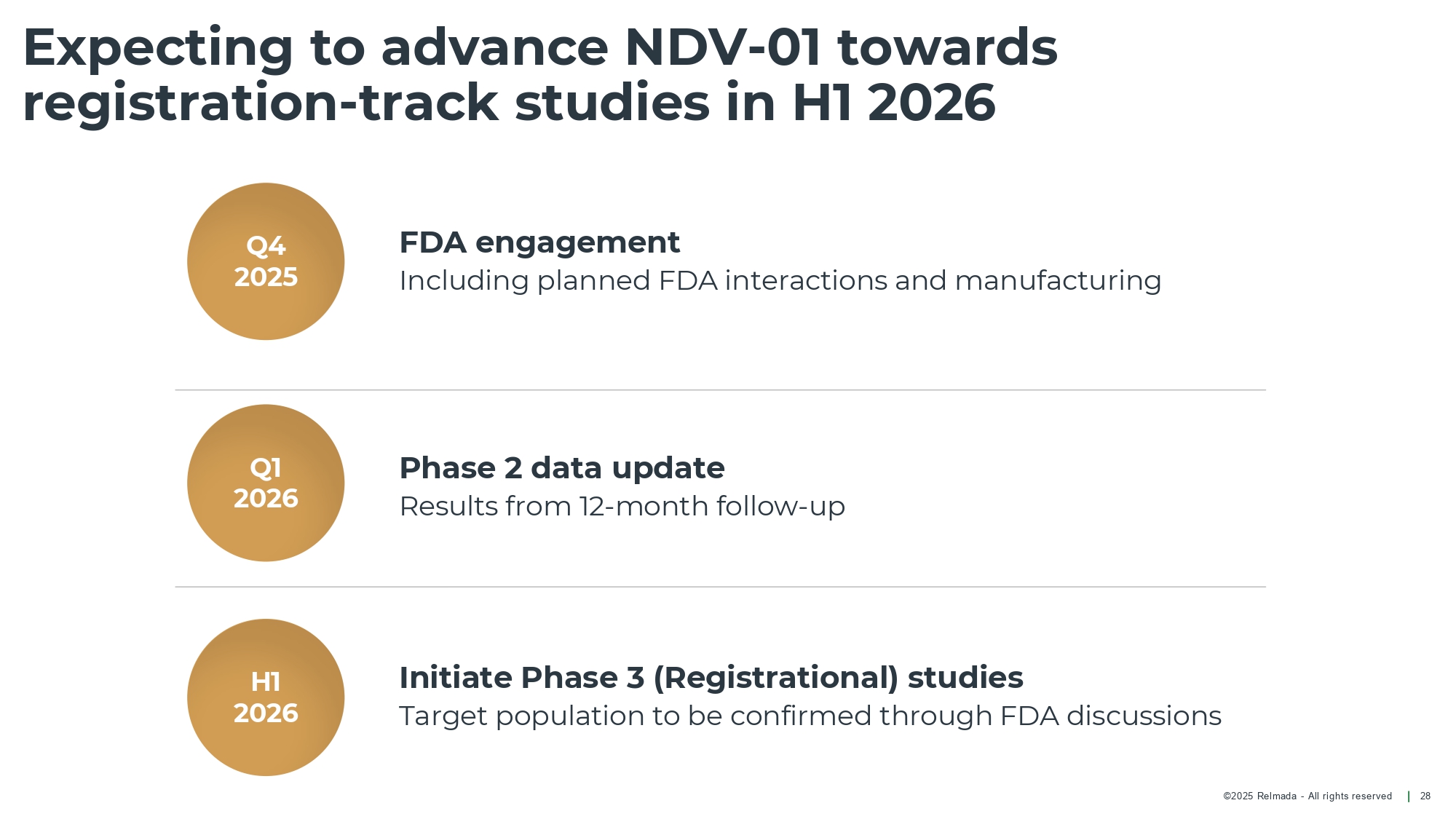
©2025 Relmada - All rights reserved Expecting to advance NDV - 01 towards registration - track studies in H1 2026 28 FDA engagement Including planned FDA interactions and manufacturing Initiate Phase 3 (Registrational) studies Target population to be confirmed through FDA discussions Phase 2 data update Results from 12 - month follow - up Q4 2025 Q1 2026 H1 2026
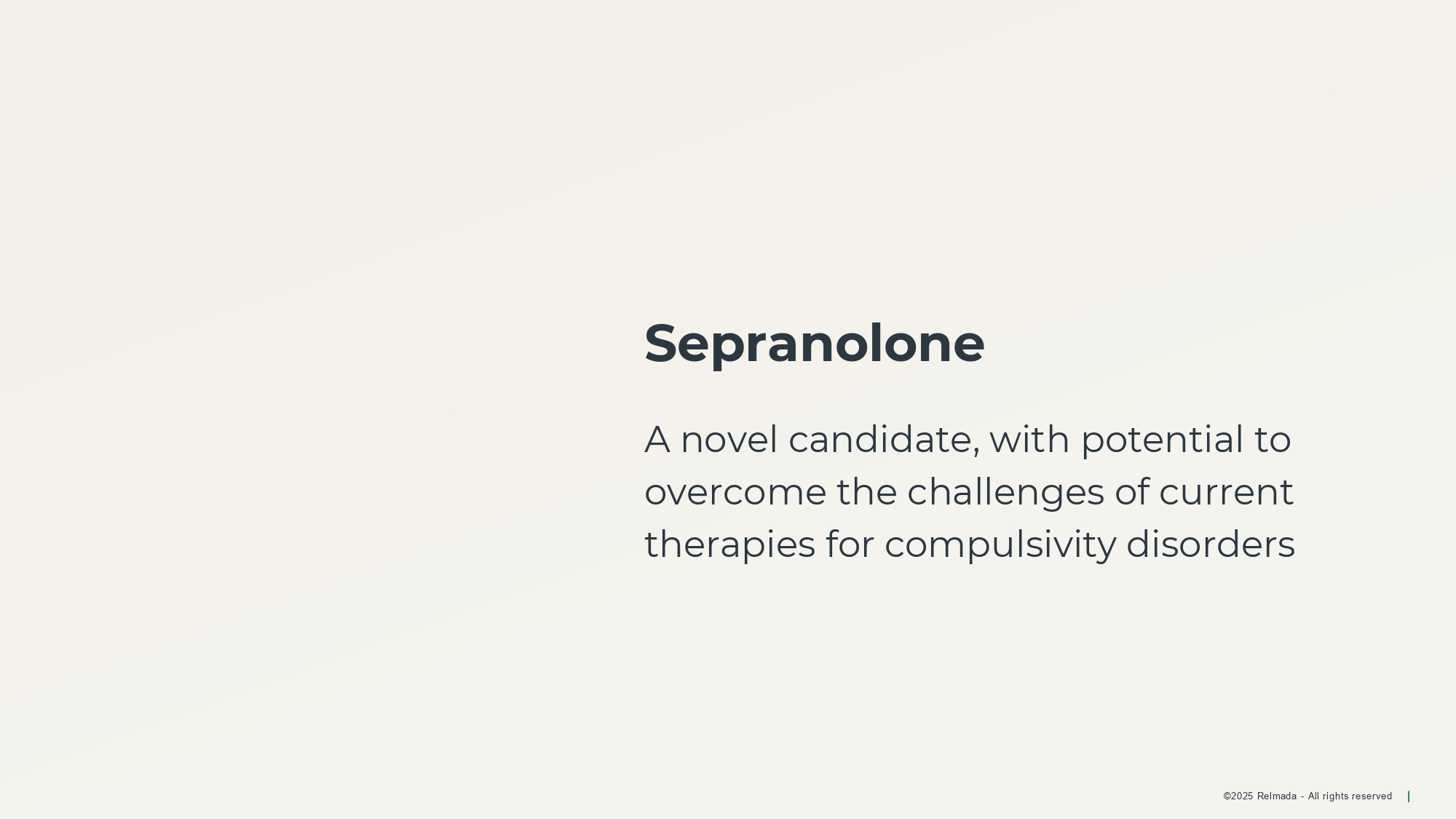
©2025 Relmada - All rights reserved Sepranolone A novel candidate, with potential to overcome the challenges of current therapies for compulsivity disorders

©2025 Relmada - All rights reserved 30 Sepranolone has the potential to normalize GABA A receptor activity GABA ( Υ - aminobutyric acid) is the primary neurotransmitter, involved in anxiety and compulsive disorders 1,2 Allopregnanolone (ALLO) typically enhances GABA A calming effects 3, 4 In some individuals, ALLO exacerbates anxiety and compulsivity 5, 6 Sepranolone normalizes GABA A receptor activity without interfering in GABA signaling 7, 8 1. Nuss et al., Neuropsychiatr Dis Treat 2015; Möhler, Neuropharmacology 2012; Belelli & Lambert, Nat Rev Neurosci 2005; Majewska et al., Science 1986; Girdler et al., Biol Psychiatry 2001; Martinez et al., NPP 2016; Bixo et al., Psychoneuroendocrinology 2018; Poromaa et al., Front Neuroendocrinol 2020; 2. Möhler, H. (2012). The GABA system in anxiety and depression and its therapeutic potential. Neuropharmacology, 62(1), 42 – 53. https://doi.org/10.1016/j.neuropharm.2011.08.040 ; 3. Belelli, D., & Lambert, J.J. (2005). Neurosteroids: Endogenous regulators of the GABAA receptor. Nature Reviews Neuroscience, 6(7), 565 – 575. https://www.nature.com/articles/nrn1703 ; 4. Majewska, M.D. et al. (1986). Steroid hormone metabolites are barbiturate - like modulators of the GABA receptor.Science, 232(4753), 1004 – 1007. https://doi.org/10.1126/science.2422758 . 5. Girdler, S.S. et al. (2001). Allopregnanolone levels and reactivity to stress in premenstrual dysphoric disorder.Biological Psychiatry, 49(9), 788 – 797. https://www.biologicalpsychiatryjournal.com/article/S0006 - 3223(00)01044 - 1/abstract ; 6. Bixo M, Stiernman L, Bäckström T. Neurosteroids and premenstrual dysphoric disorder. Br J Psychiatry. 2025 Jun 16:1 - 9 https://www.cambridge.org/core/journals/the - british - journa l - of - psychiatry/article/neurosteroids - and - premenstrual - dysphoric - disorder/9F749CEEE76E6DEDD72CF39980CCF77B ; 7. Bixo M. et al., Treatment of premenstrual dysphoric disorder with the GABAA receptor modulating steroid antagonist Sepranolone (UC1010) - A randomized controlled trial. Psychoneuroendocrinology. 2017 Jun;80:46 - 55. doi: 10.1016/j.psyneuen.2017.02.031. Epub 2017 Mar 1.; https://www.sciencedirect.com/science/article/pii/S0306453016309180?via%3Dihub 8. Bäckström T, Ekberg K, Hirschberg AL, Bixo M, Epperson CN, Briggs P, Panay N, O'Brien S. A randomized, double - blind study on efficacy and safety of sepranolone in premenstrual dysphoric disorder. Psychoneuroendocrinology. 2021 Nov;133:105426. https://www.sciencedirect.com/science/article/pii/S0306453021003000?via%3Dihub .; GABA A : Υ - aminobutyric acid type A; ALLO: Allopregnanolone;
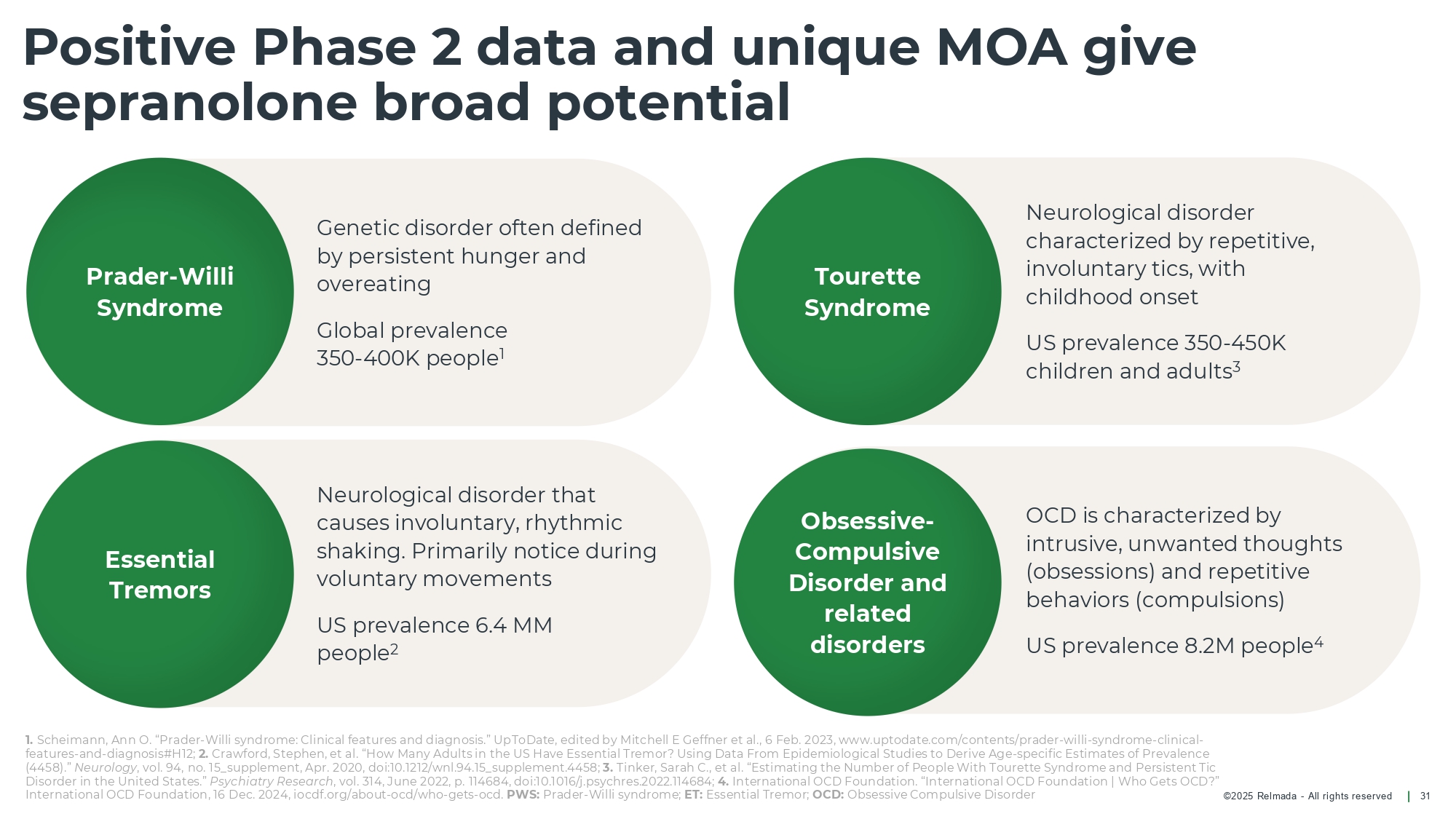
©2025 Relmada - All rights reserved OCD is characterized by intrusive, unwanted thoughts (obsessions) and repetitive behaviors (compulsions) US prevalence 8.2M people 4 Neurological disorder characterized by repetitive, involuntary tics, with childhood onset US prevalence 350 - 450K children and adults 3 Neurological disorder that causes involuntary, rhythmic shaking. Primarily notice during voluntary movements US prevalence 6.4 MM people 2 Genetic disorder often defined by persistent hunger and overeating Global prevalence 350 - 400K people 1 Positive Phase 2 data and unique MOA give sepranolone broad potential 31 Prader - Willi Syndrome Essential Tremors Tourette Syndrome Obsessive - Compulsive Disorder and related disorders 1. Scheimann, Ann O. “Prader - Willi syndrome: Clinical features and diagnosis.” UpToDate, edited by Mitchell E Geffner et al., 6 Feb. 2023, www.uptodate.com/contents/prader - willi - syndrome - clinical - features - and - diagnosis#H12; 2. Crawford, Stephen, et al. “How Many Adults in the US Have Essential Tremor? Using Data From Epidemiological Studies to Derive Age - specific Estimates of Prevalence (4458).” Neurology , vol. 94, no. 15_supplement, Apr. 2020, doi:10.1212/wnl.94.15_supplement.4458; 3. Tinker, Sarah C., et al. “Estimating the Number of People With Tourette Syndrome and Persistent Tic Disorder in the United States.” Psychiatry Research , vol. 314, June 2022, p. 114684, doi:10.1016/j.psychres.2022.114684; 4. International OCD Foundation. “International OCD Foundation | Who Gets OCD?” International OCD Foundation, 16 Dec. 2024, iocdf.org/about - ocd/who - gets - ocd. PWS: Prader - Willi syndrome; ET: Essential Tremor; OCD: Obsessive Compulsive Disorder
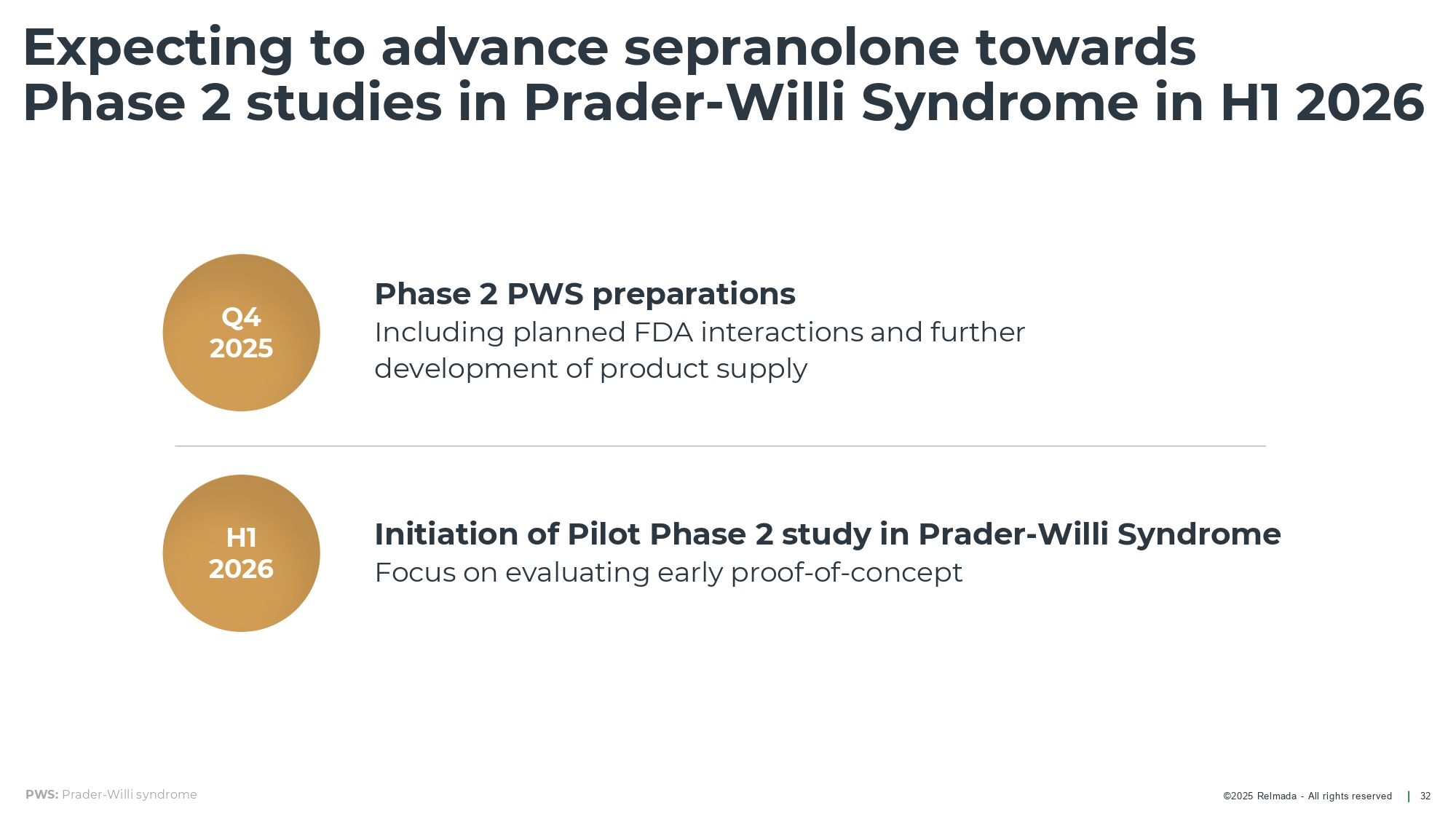
©2025 Relmada - All rights reserved Expecting to advance sepranolone towards Phase 2 studies in Prader - Willi Syndrome in H1 2026 32 Phase 2 PWS preparations Including planned FDA interactions and further development of product supply Initiation of Pilot Phase 2 study in Prader - Willi Syndrome Focus on evaluating early proof - of - concept PWS: Prader - Willi syndrome Q4 2025 H1 2026

©2025 Relmada - All rights reserved 33 Corporate summary

^ Expected as of September 30, 2025. We have not completed our quarter - end financial close process and this amount is preliminary, has not been audited and is subject to change upon completion of our financial statement closing procedures, and any changes could be material. Additional information and disclosures would be required for a more complete understanding of our financial position as of September 30, 2025, which are not available as of the date hereof. ^ As of September 30, 2025. *Includes 14.2 million outstanding options and ~0.8 million warrants. ©2025 Relmada - All rights reserved Financial overview 34 Common shares outstanding (~48.2 million as converted)* Cash, cash equivalents & short - term investments No outstanding debt $13.9^ million ~33.2^ million Unlevered balance sheet
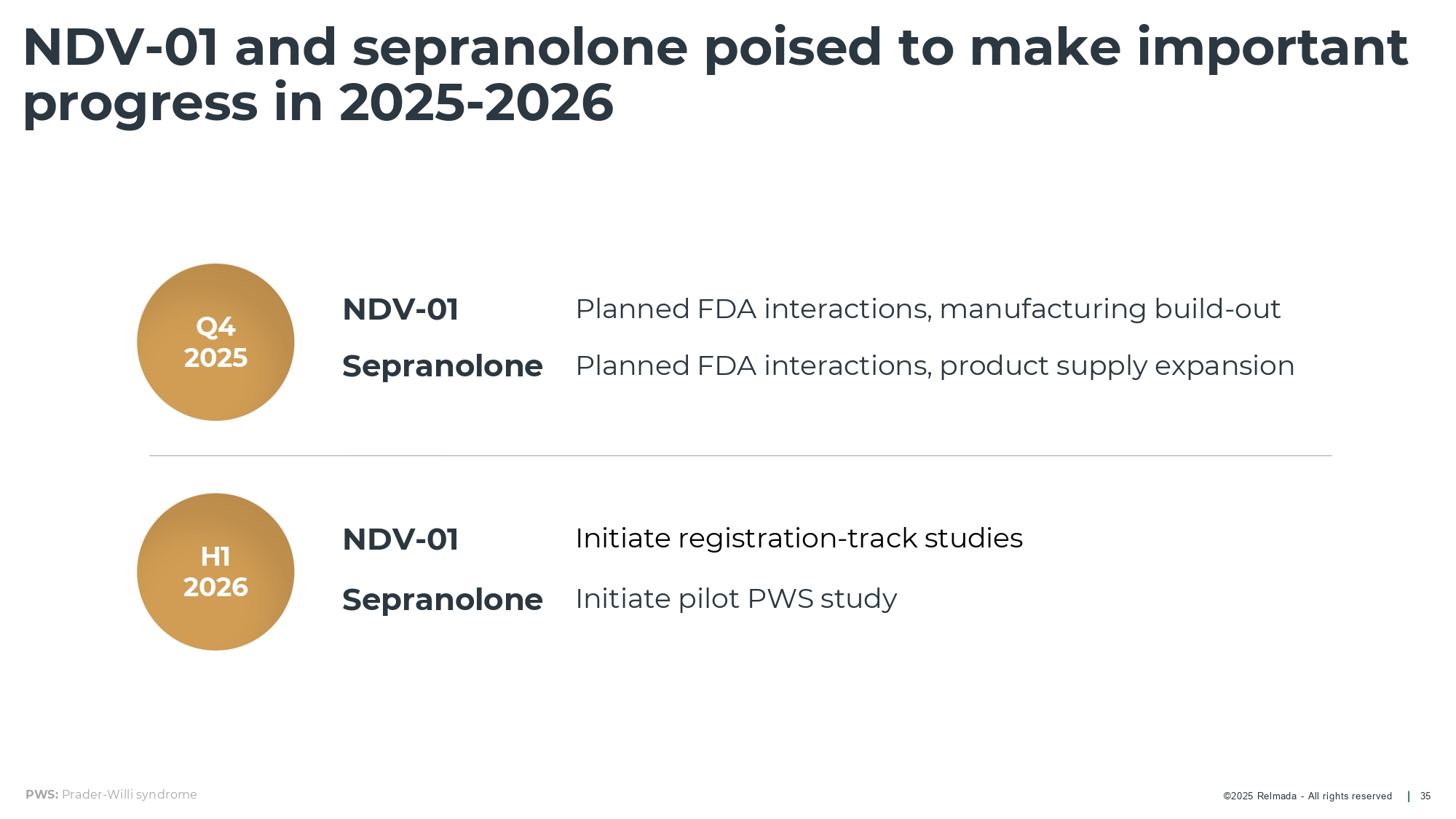
©2025 Relmada - All rights reserved NDV - 01 and sepranolone poised to make important progress in 2025 - 2026 35 Q4 2025 H1 2026 NDV - 01 Sepranolone NDV - 01 Sepranolone Planned FDA interactions, manufacturing build - out Planned FDA interactions, product supply expansion Initiate registration - track studies Initiate pilot PWS study PWS: Prader - Willi syndrome
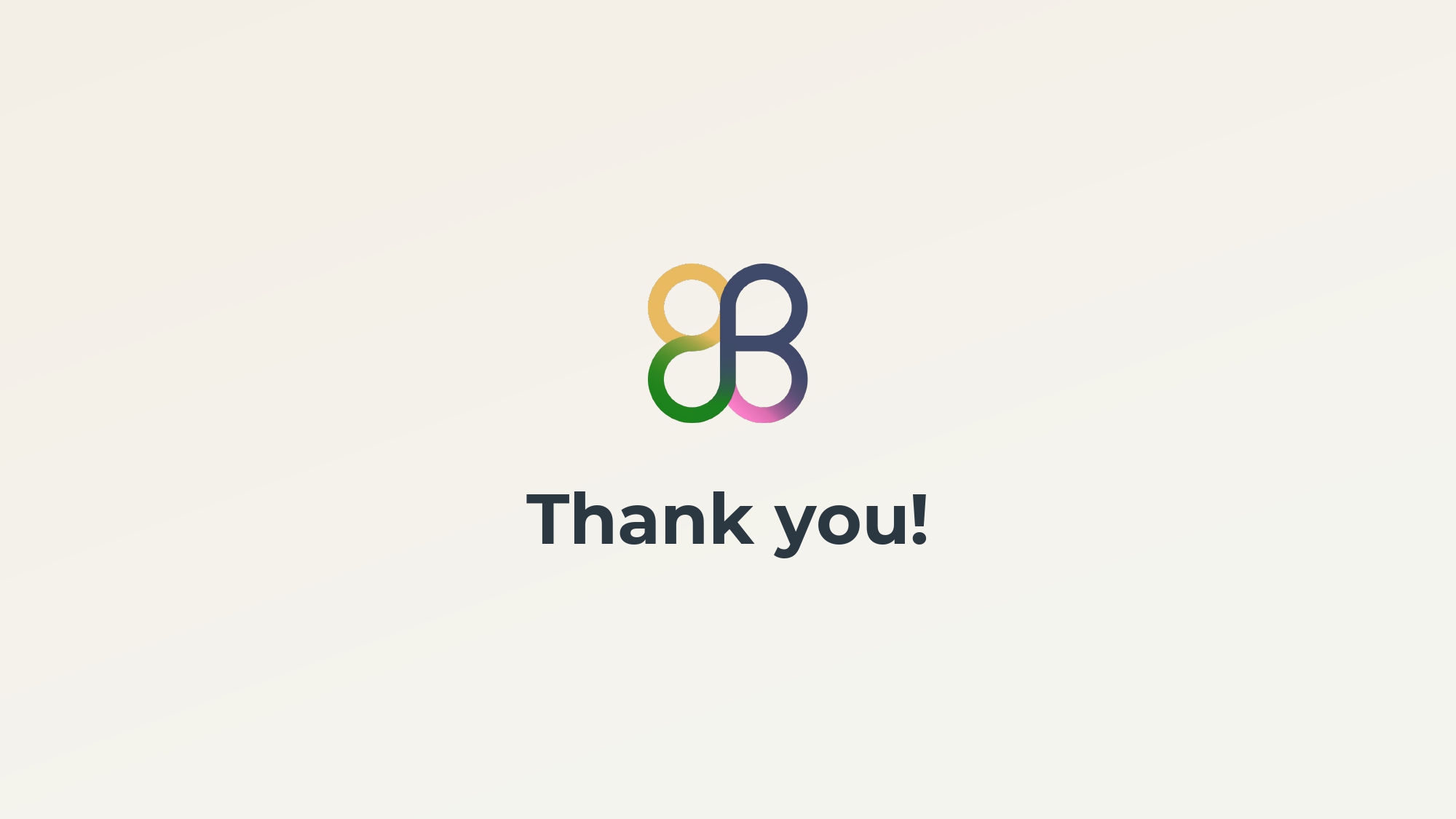
Thank you!

Appendix
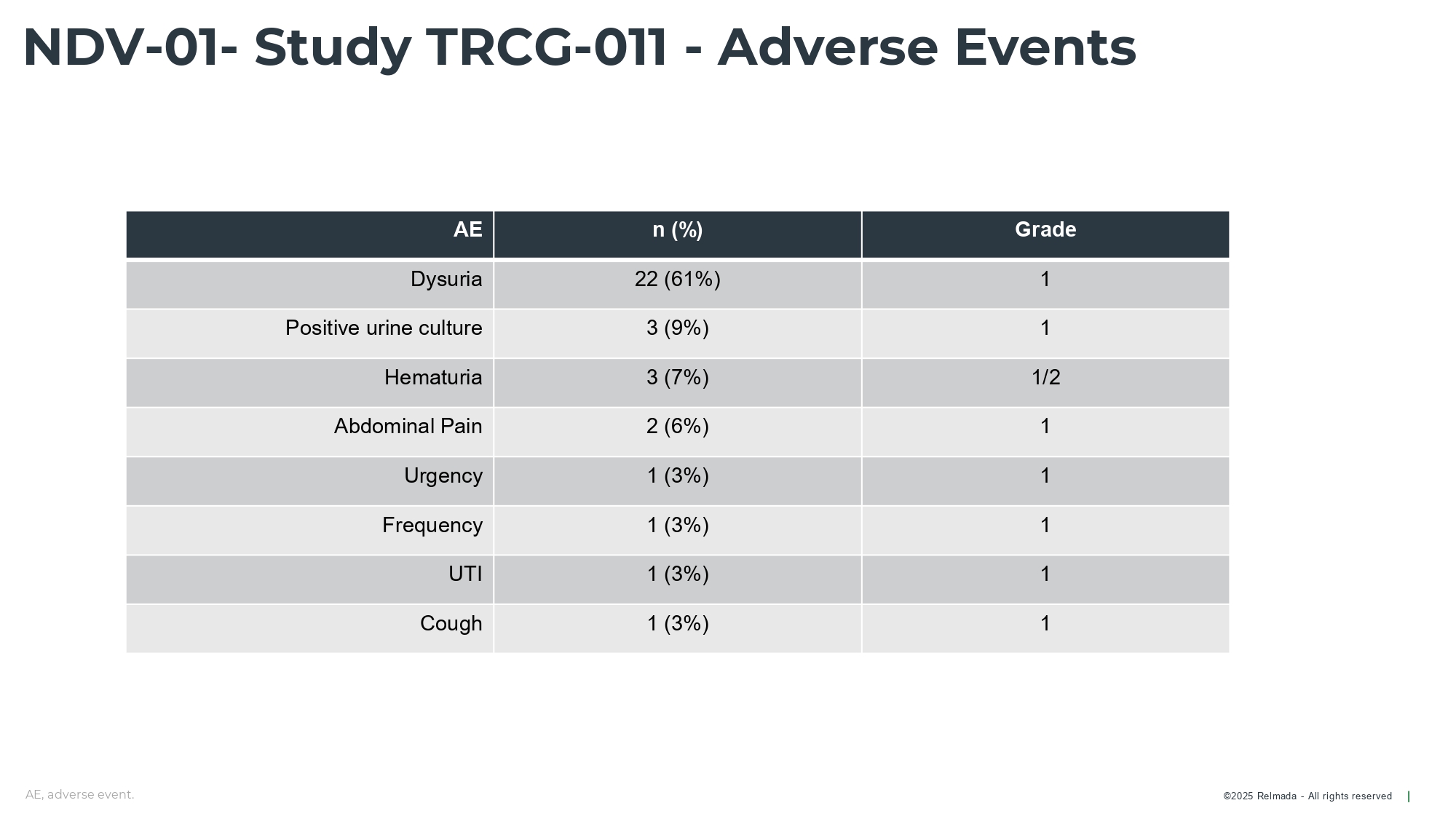
©2025 Relmada - All rights reserved Grade n (%) AE 1 22 (61%) Dysuria 1 3 (9%) Positive urine culture 1/2 3 (7%) Hematuria 1 2 (6%) Abdominal Pain 1 1 (3%) Urgency 1 1 (3%) Frequency 1 1 (3%) UTI 1 1 (3%) Cough NDV - 01 - Study TRCG - 011 - Adverse Events AE, adverse event.
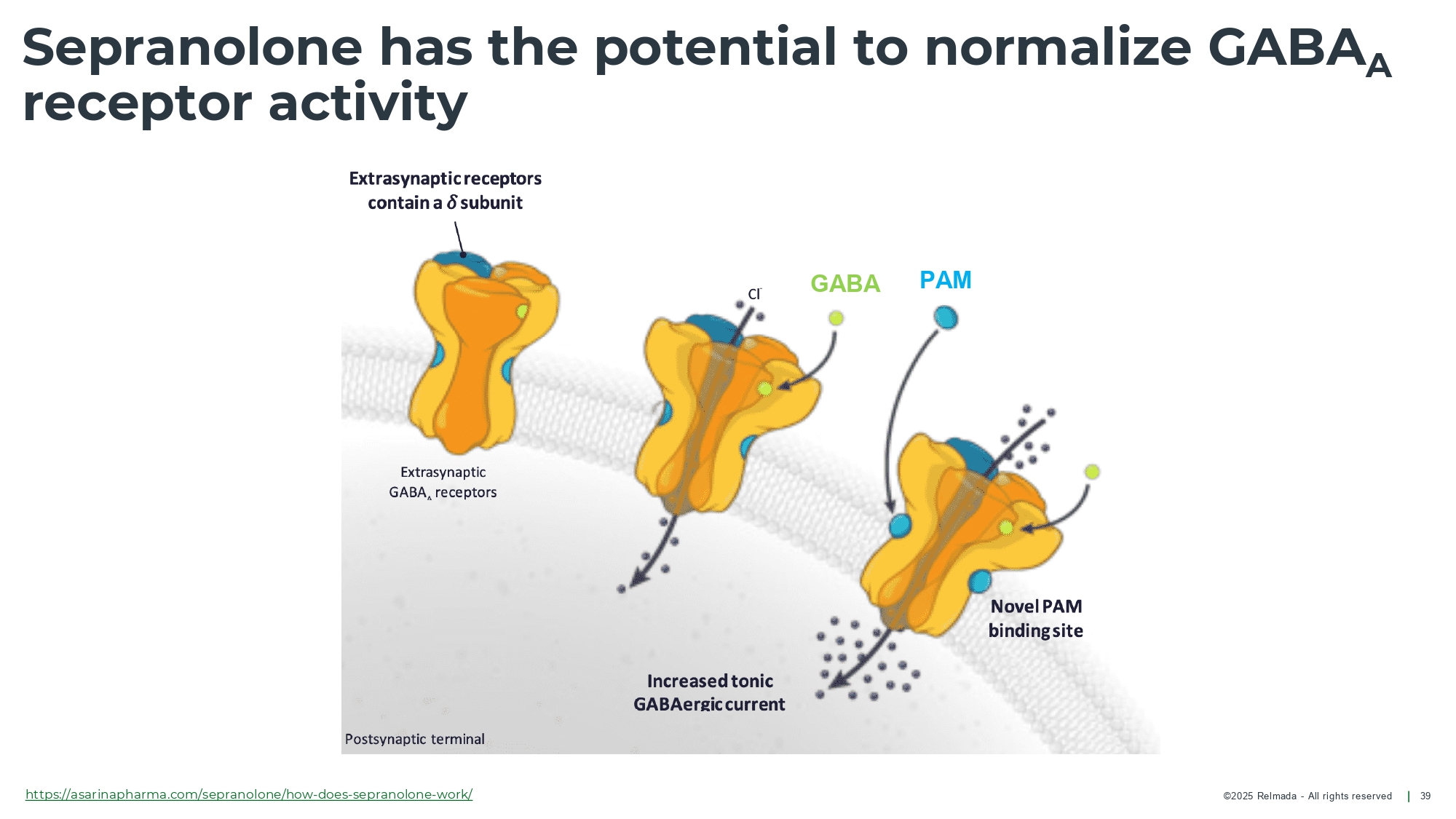
©2025 Relmada - All rights reserved Sepranolone has the potential to normalize GABA A receptor activity 39 GABA PAM https://asarinapharma.com/sepranolone/how - does - sepranolone - work/